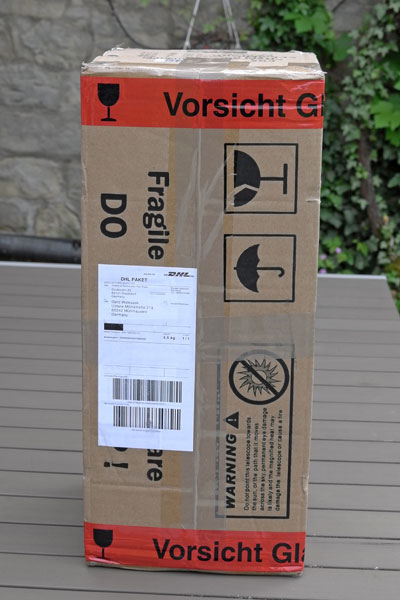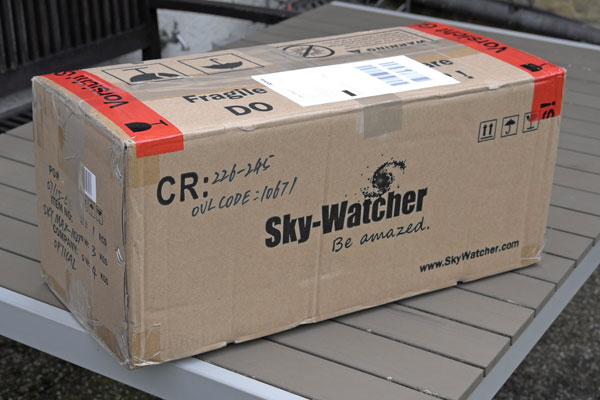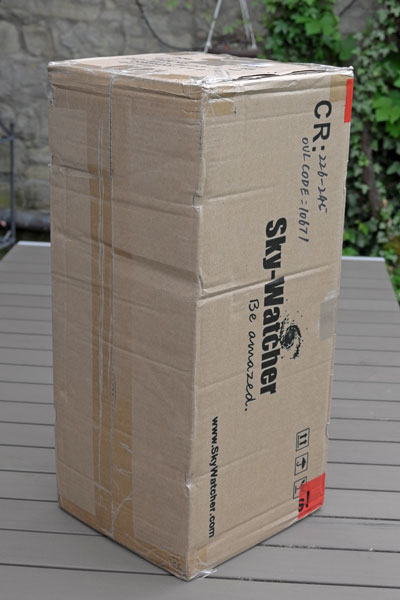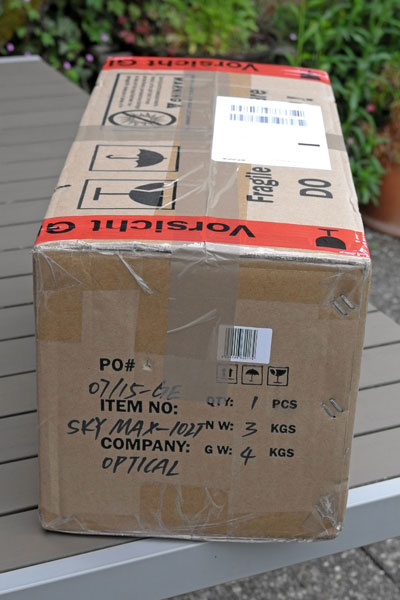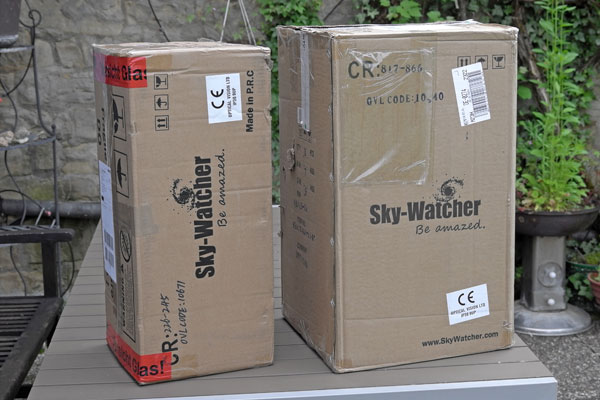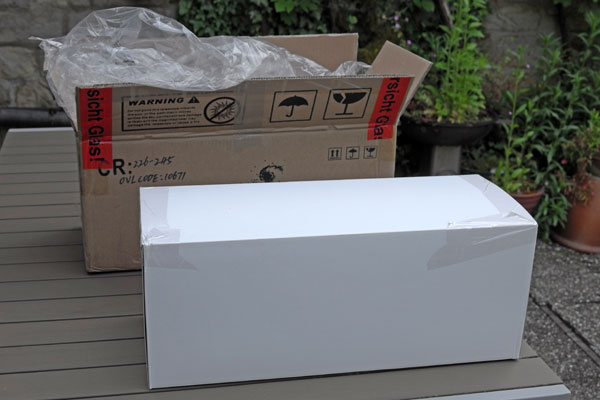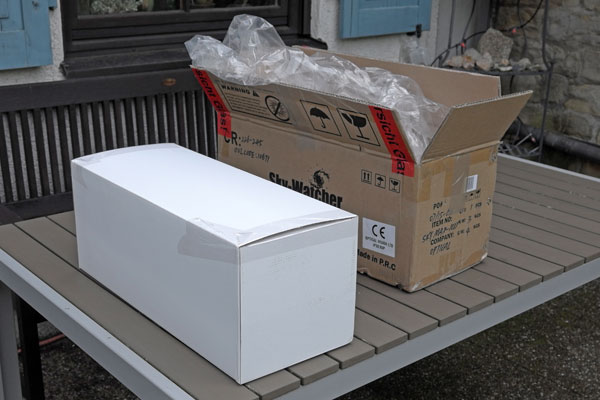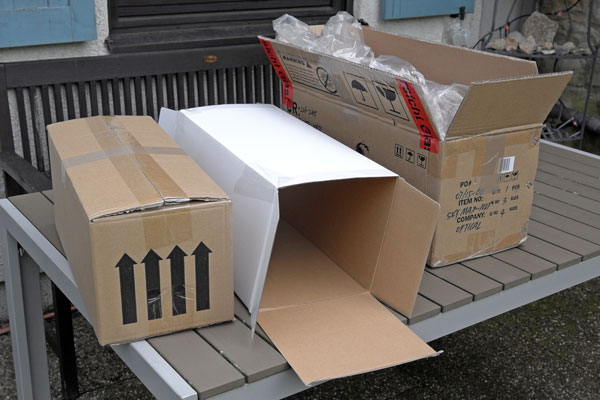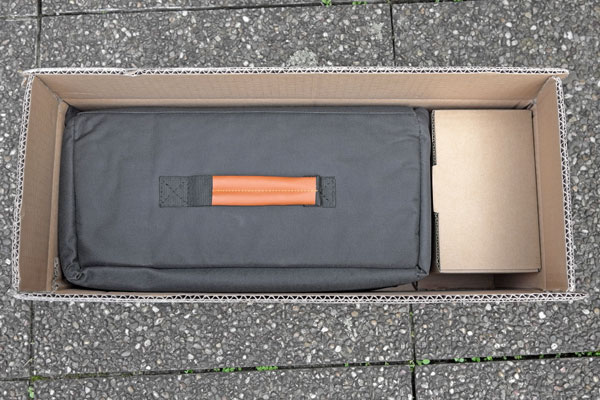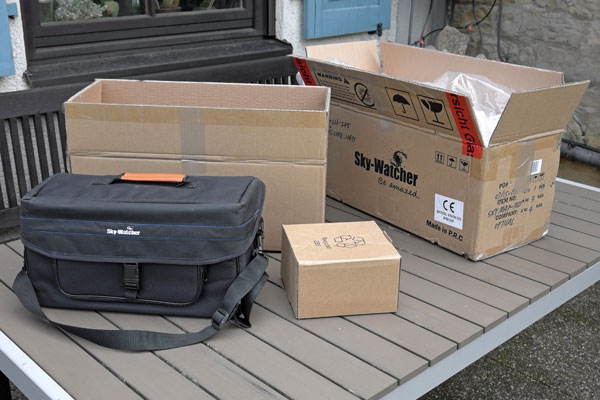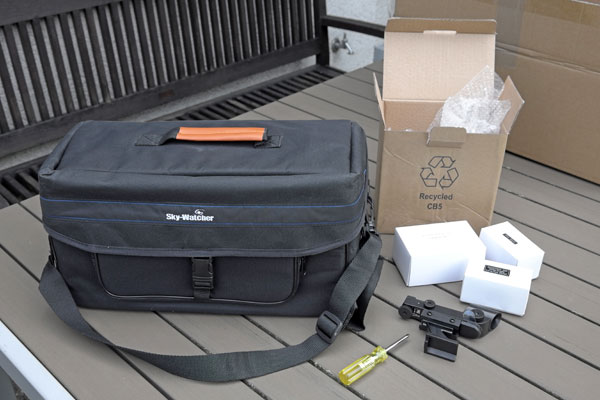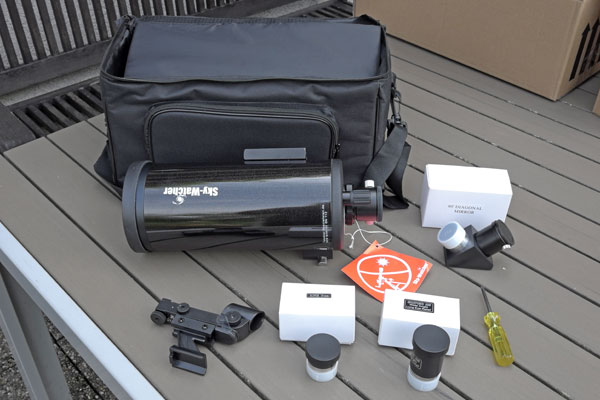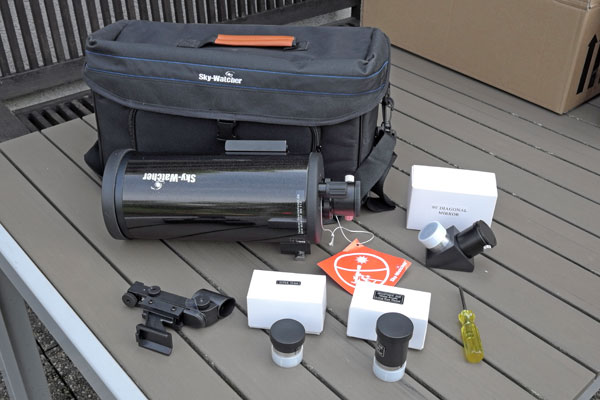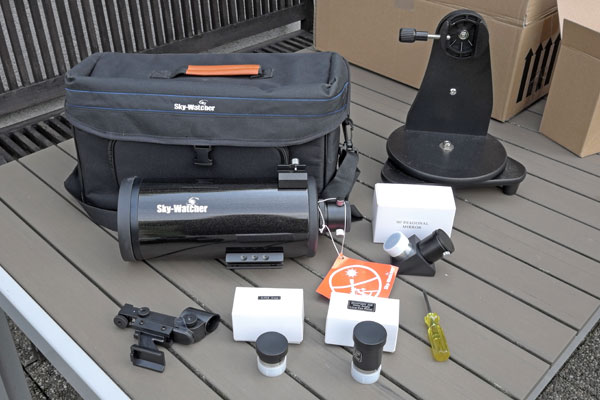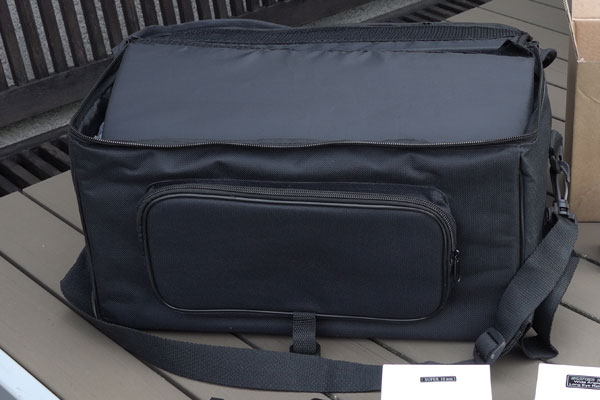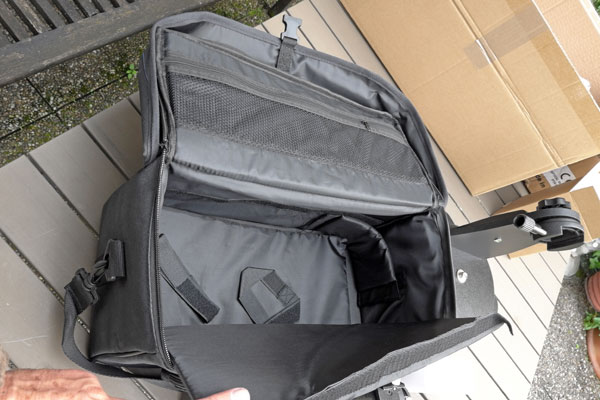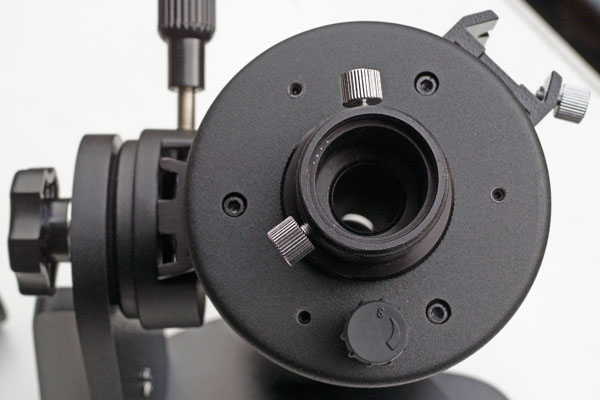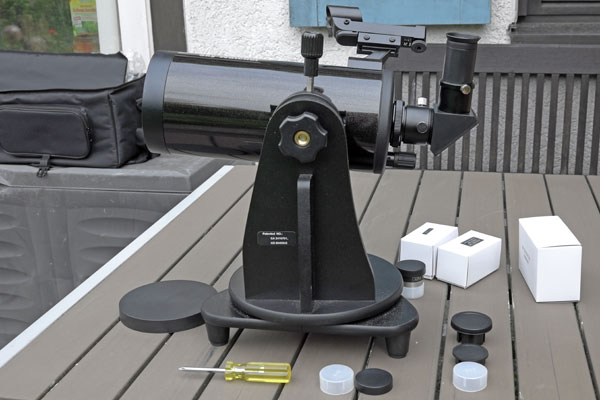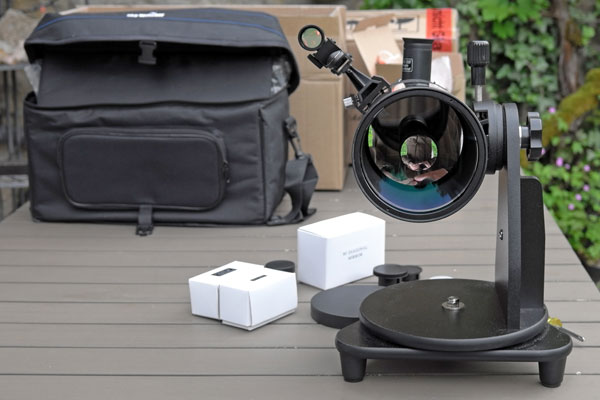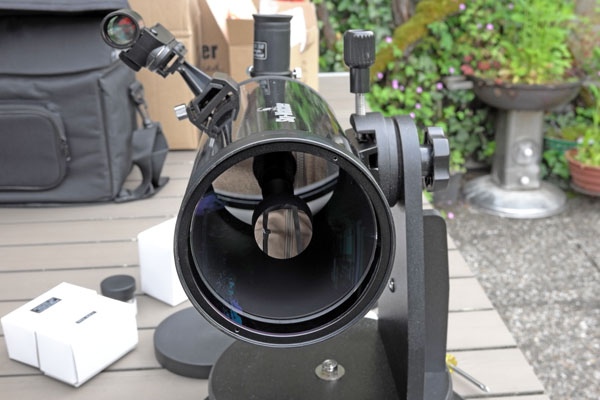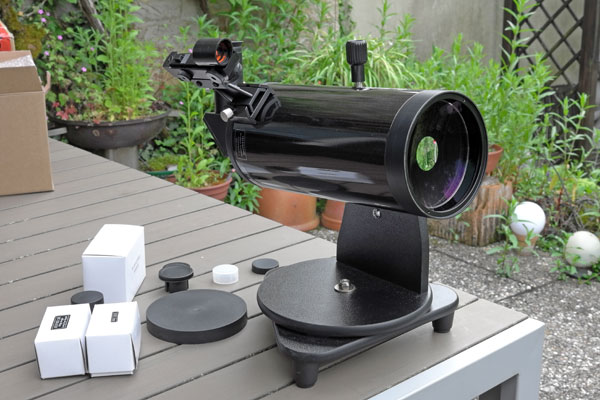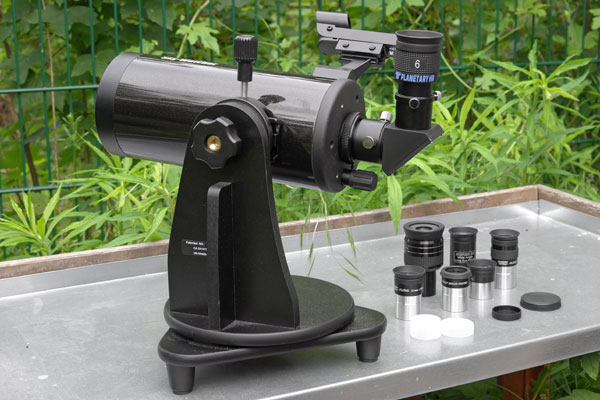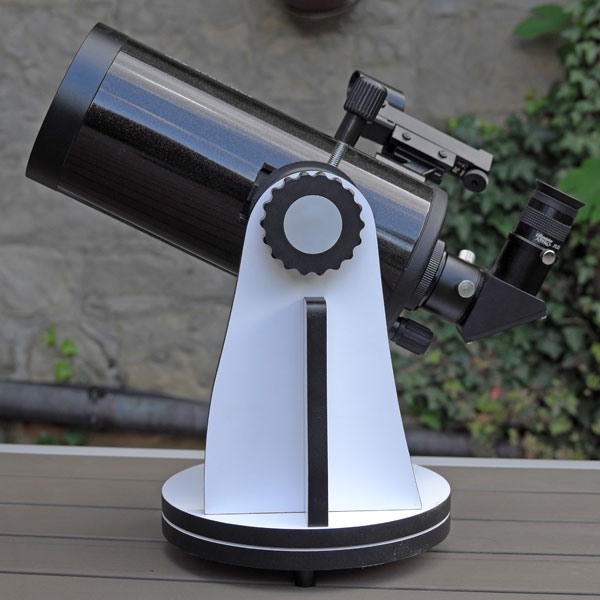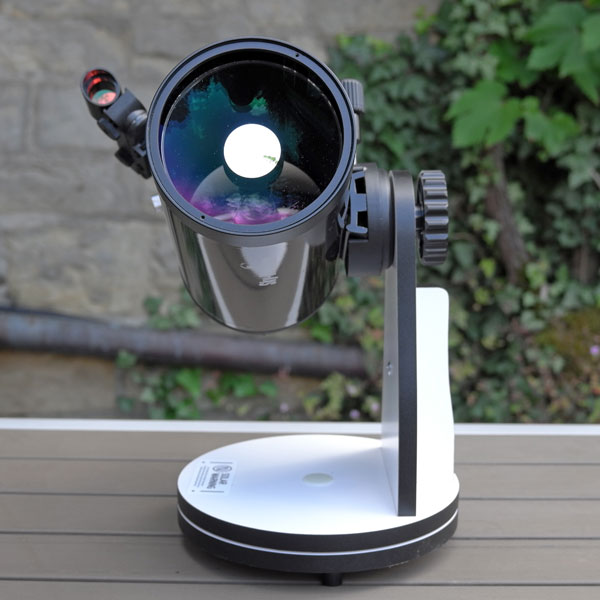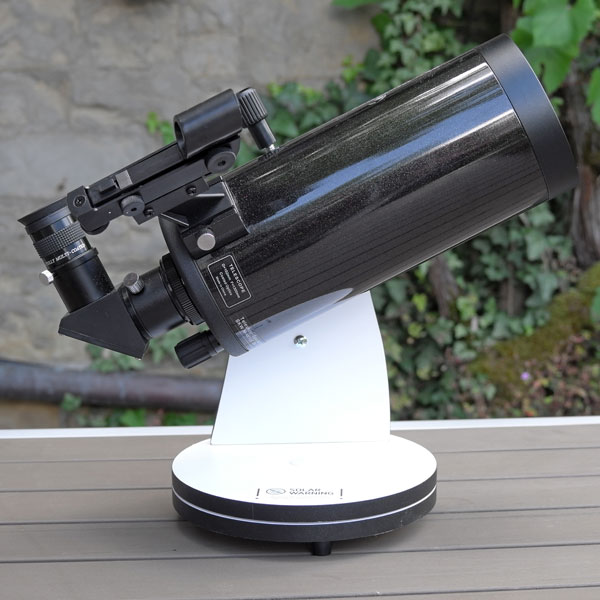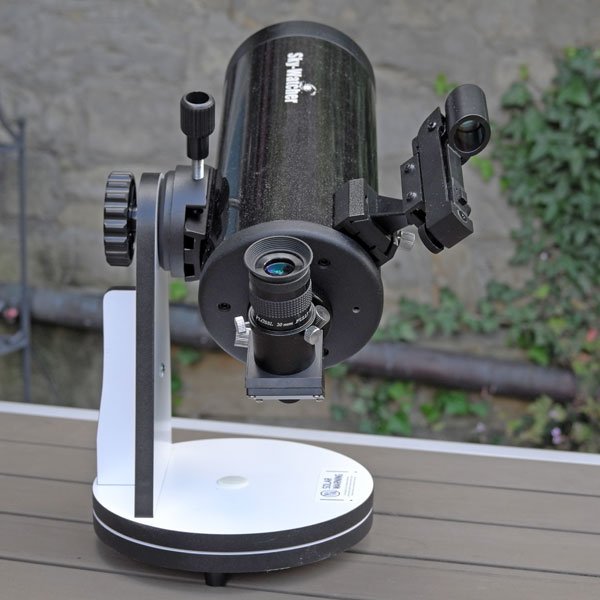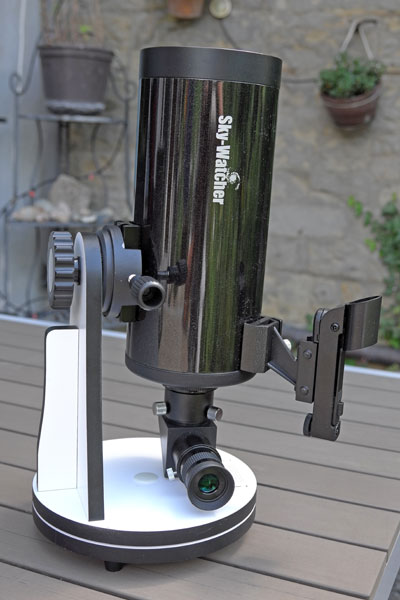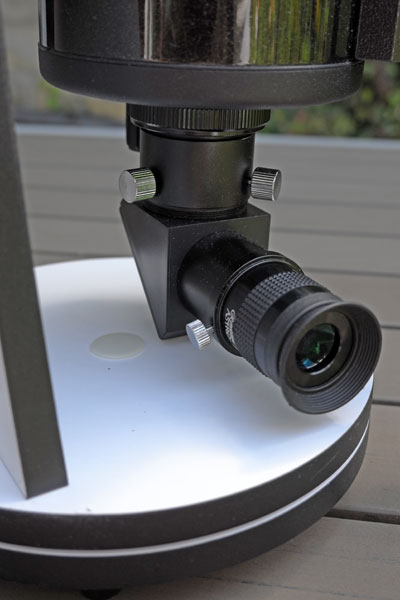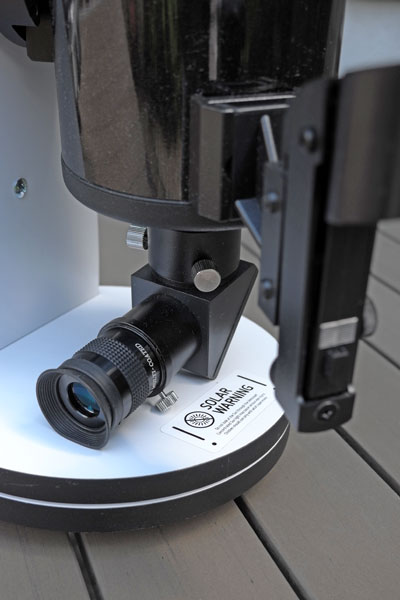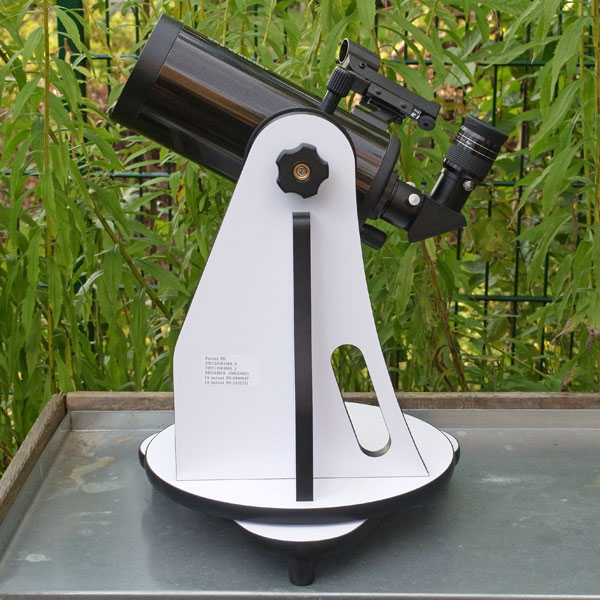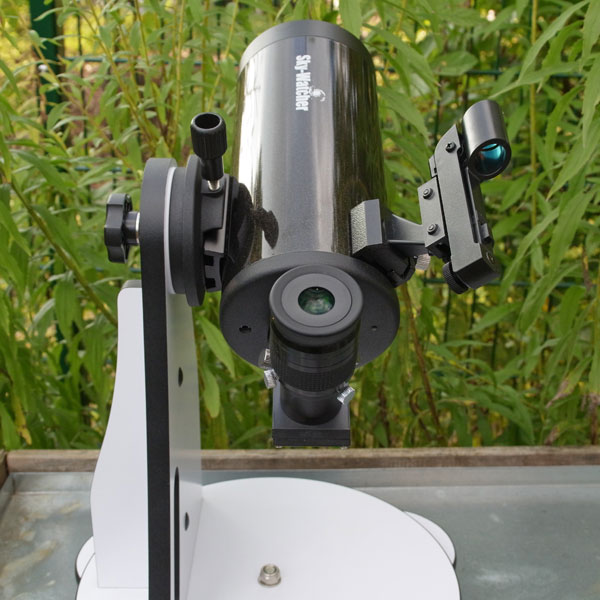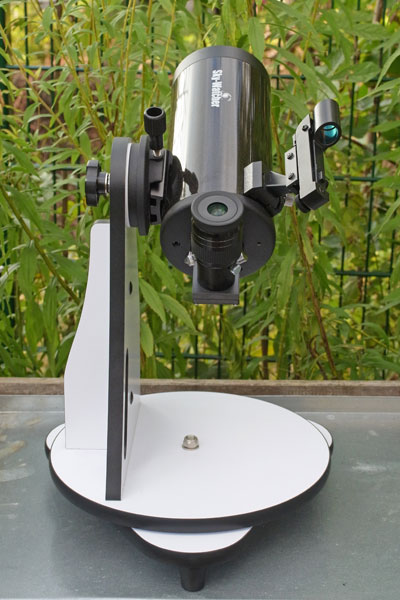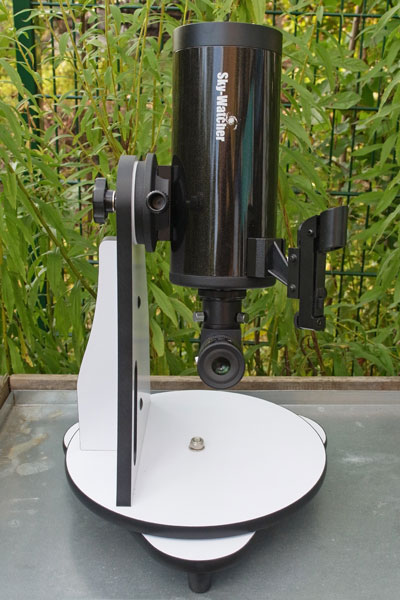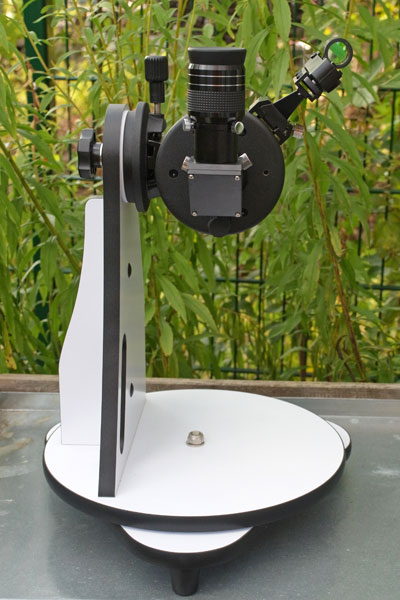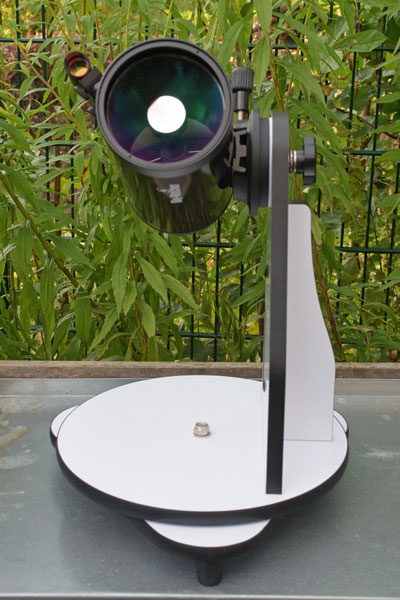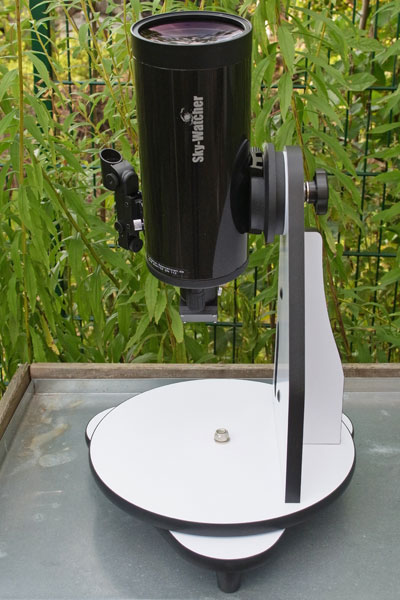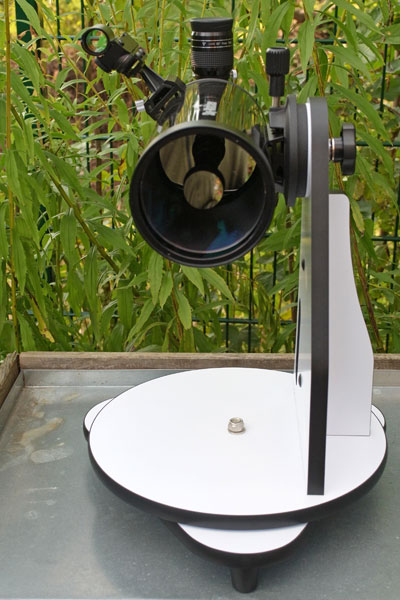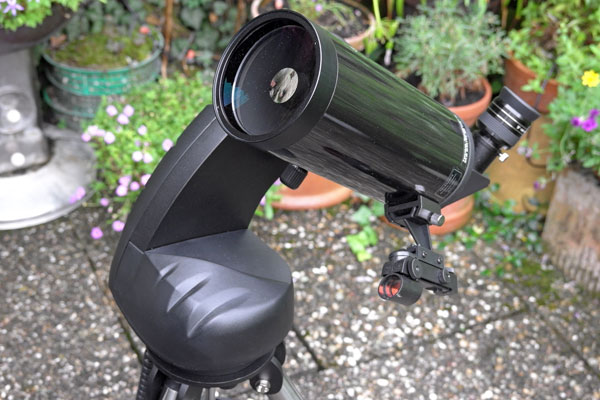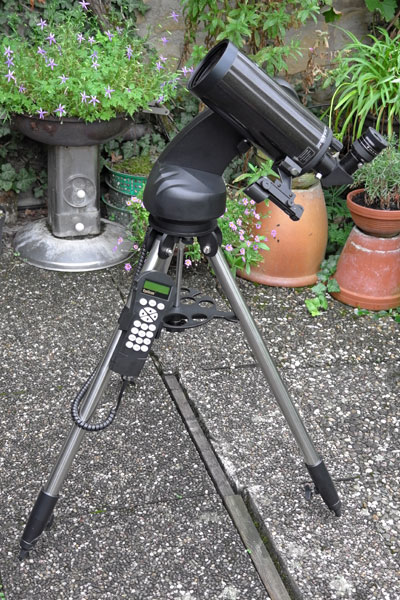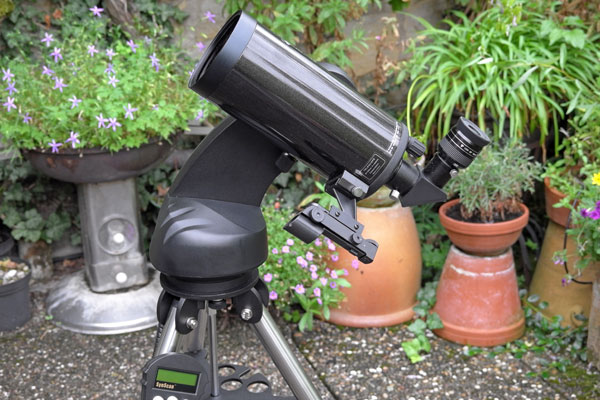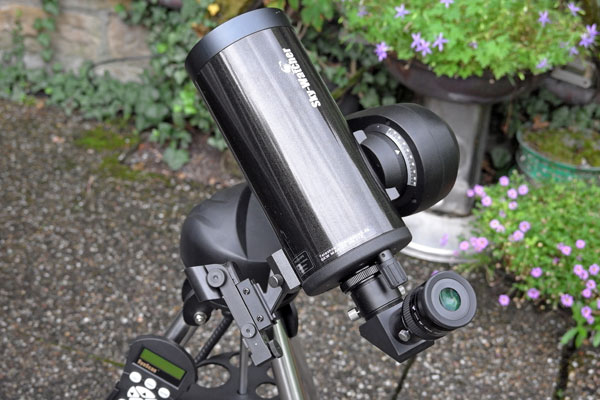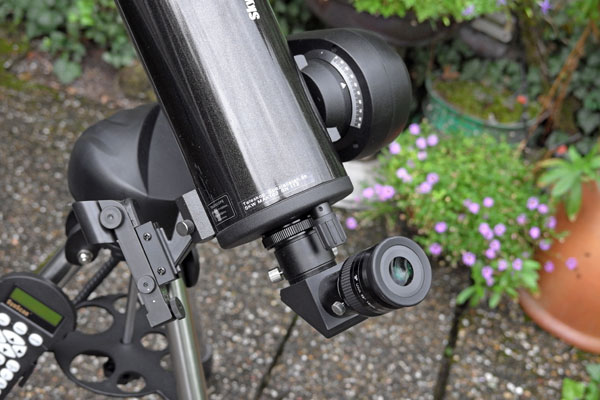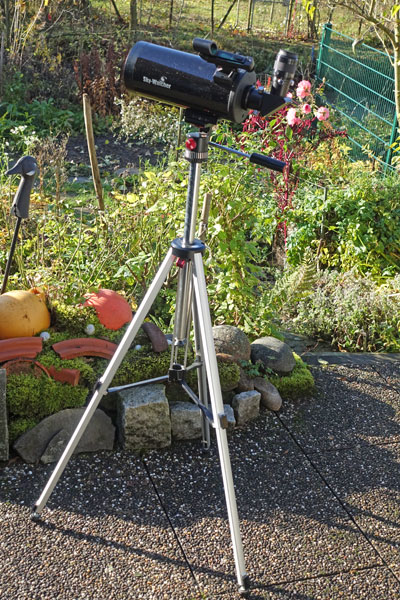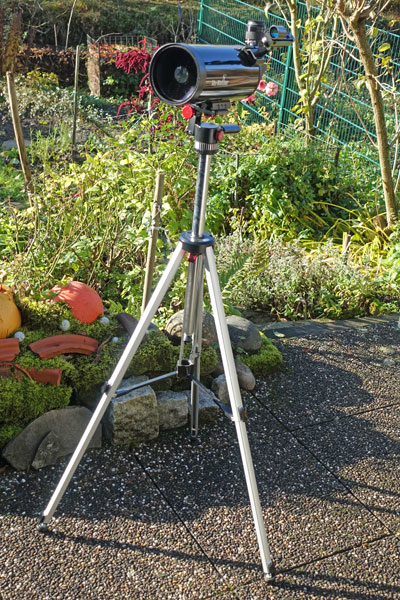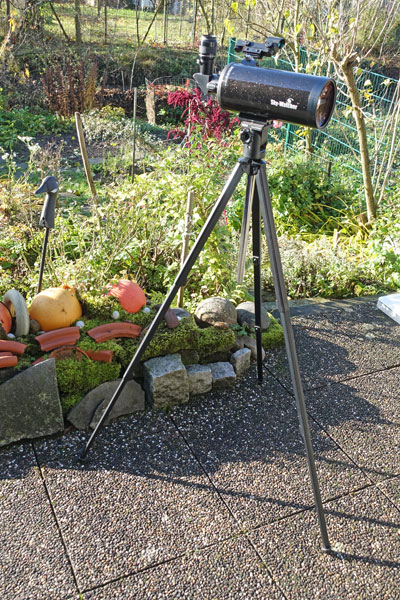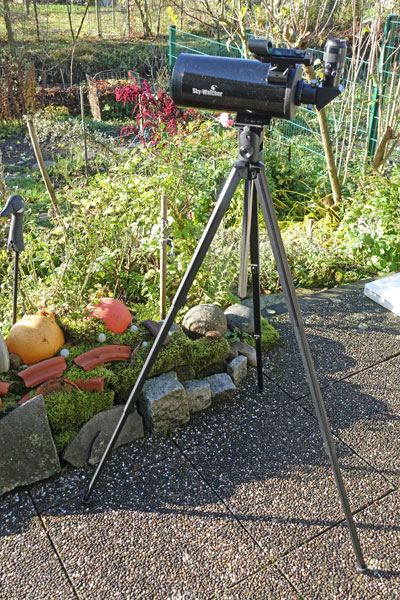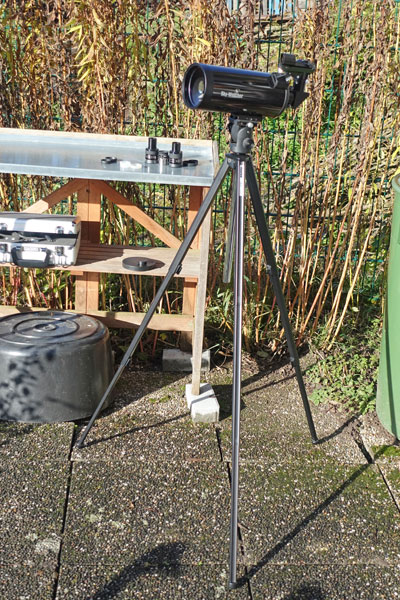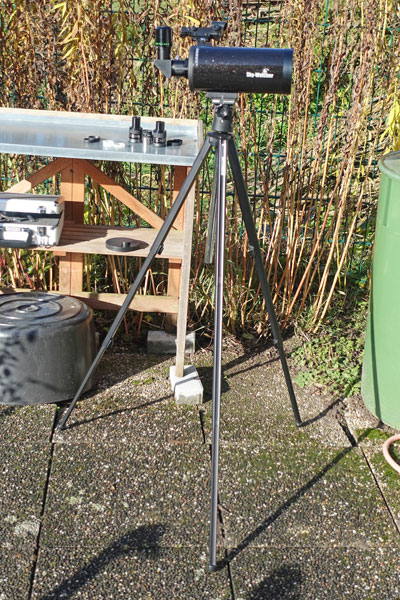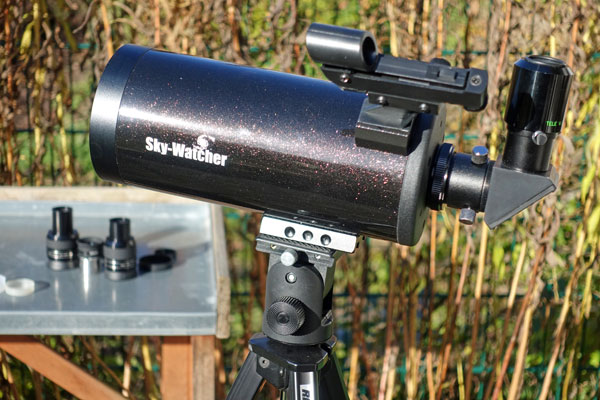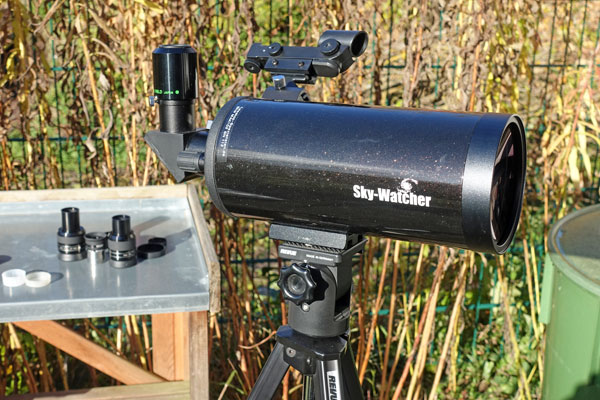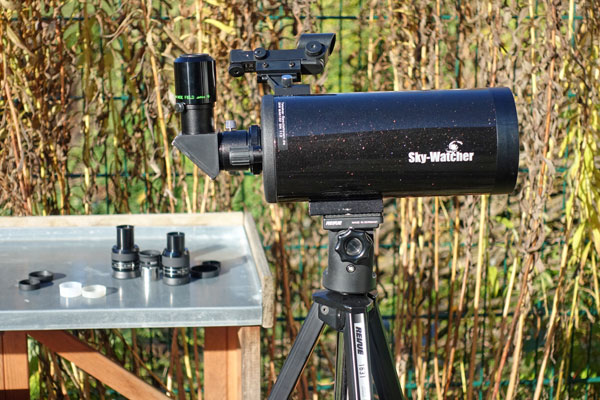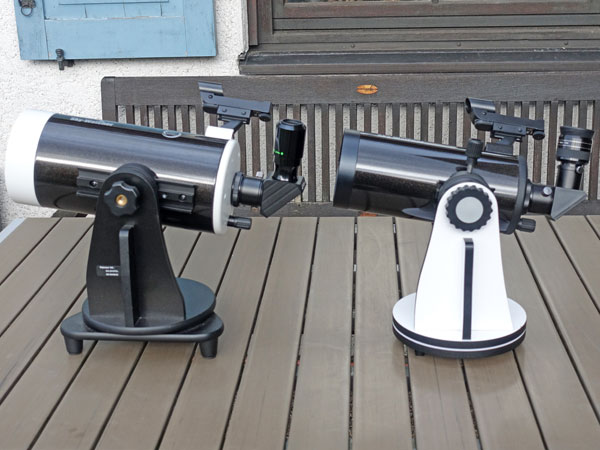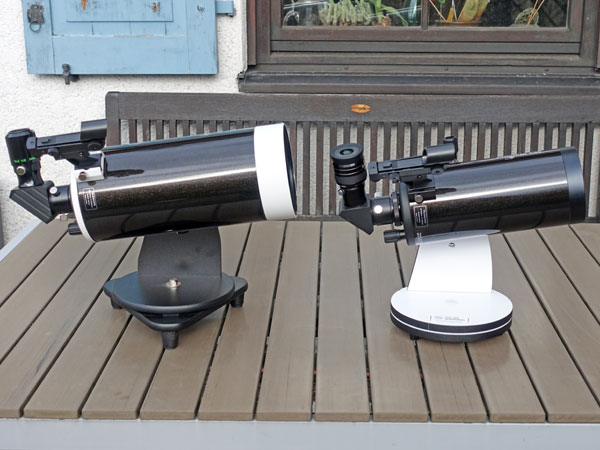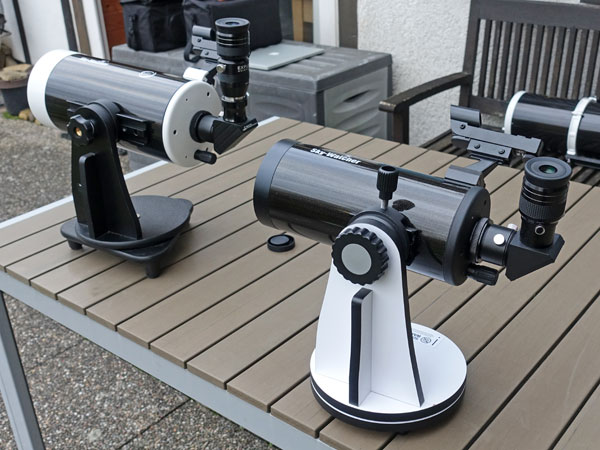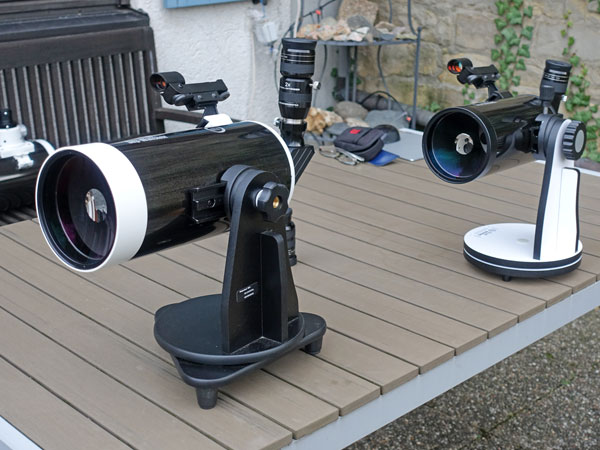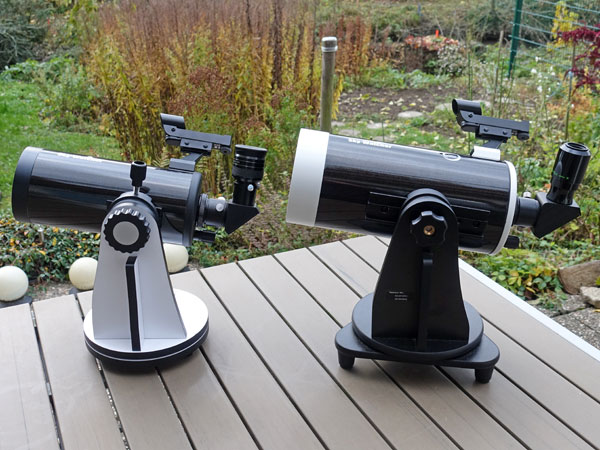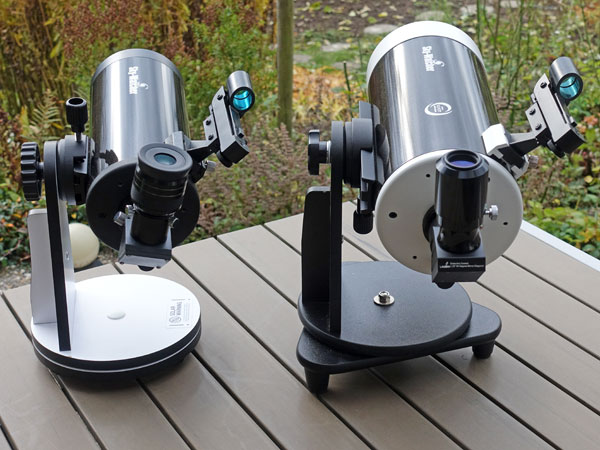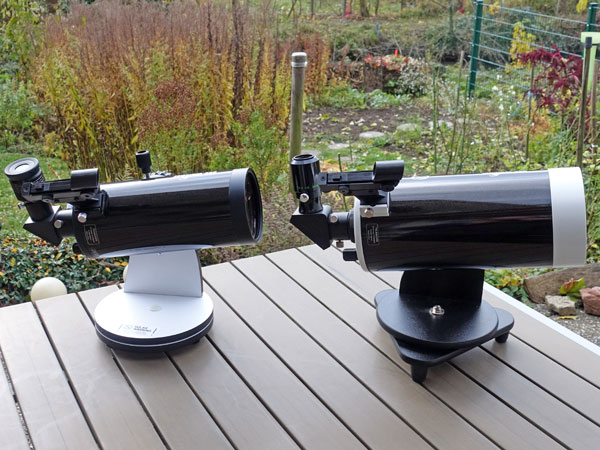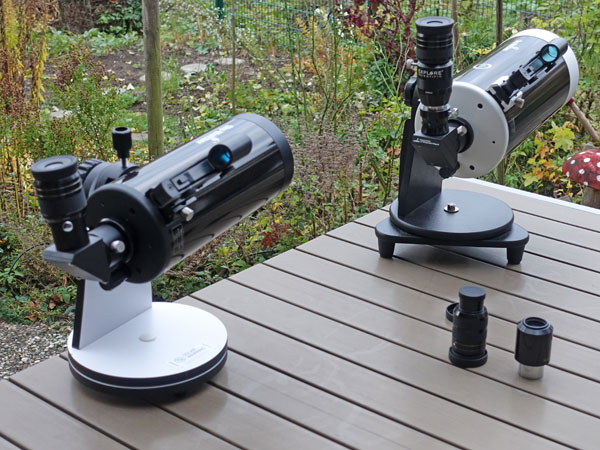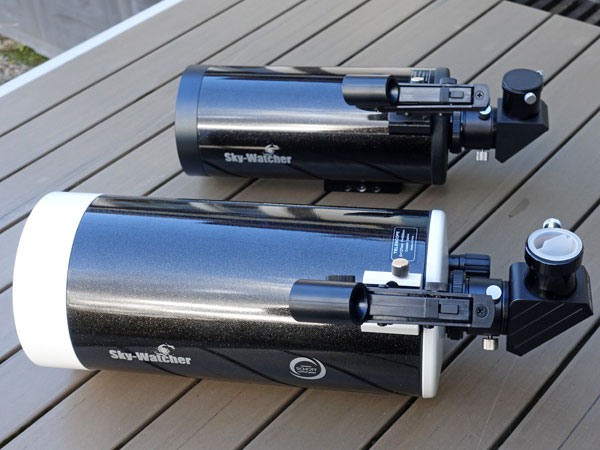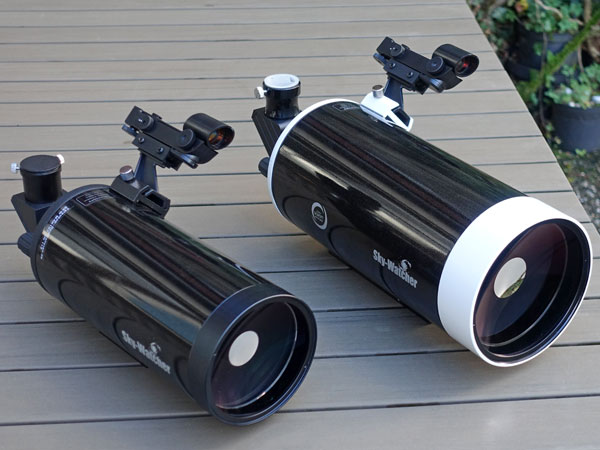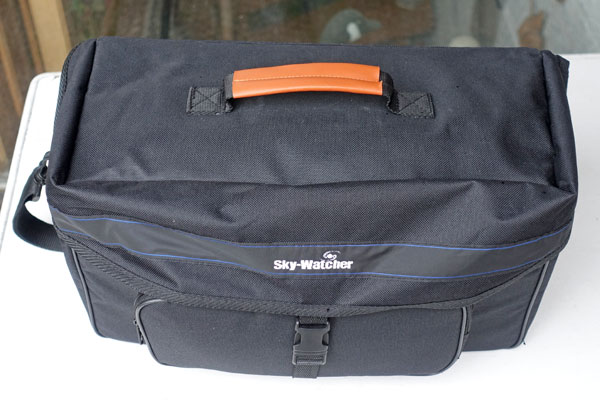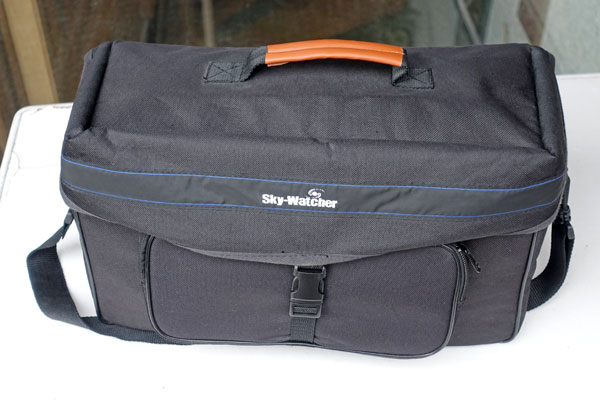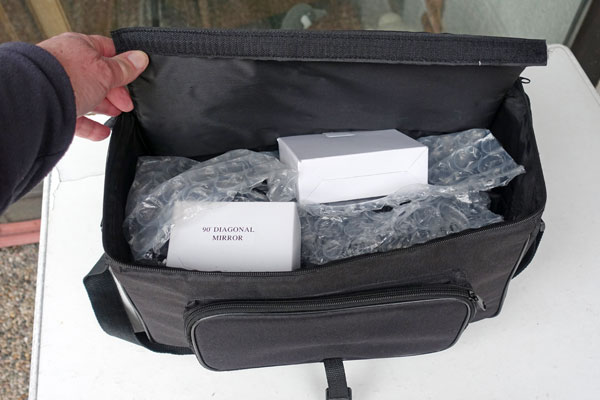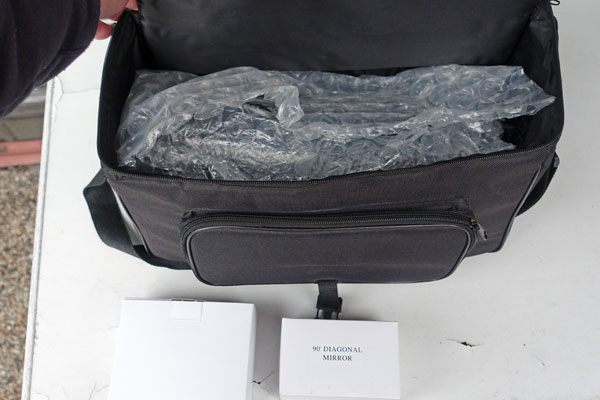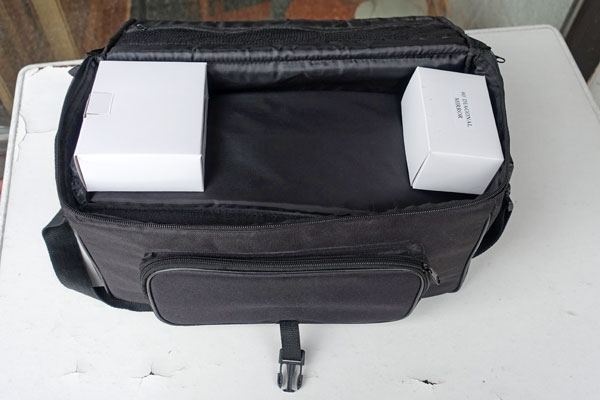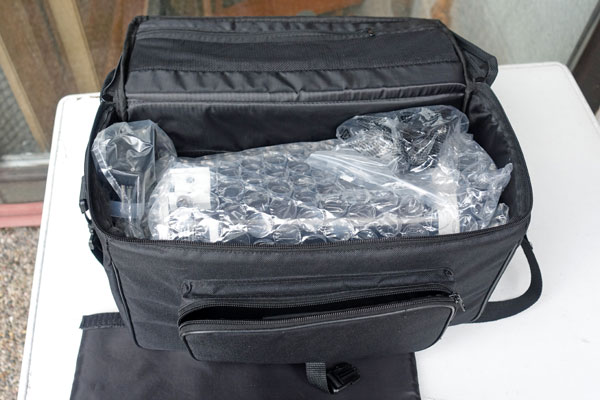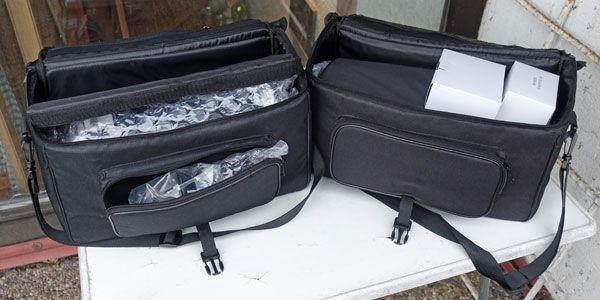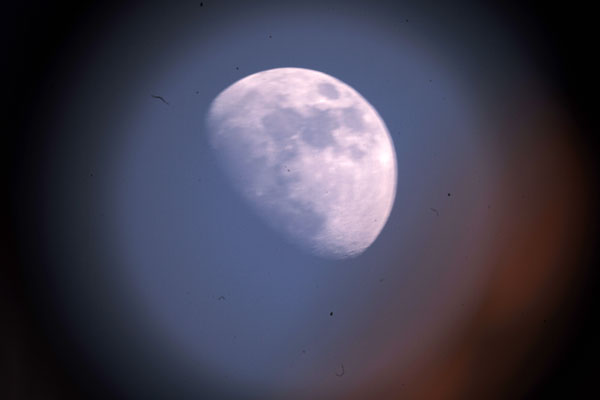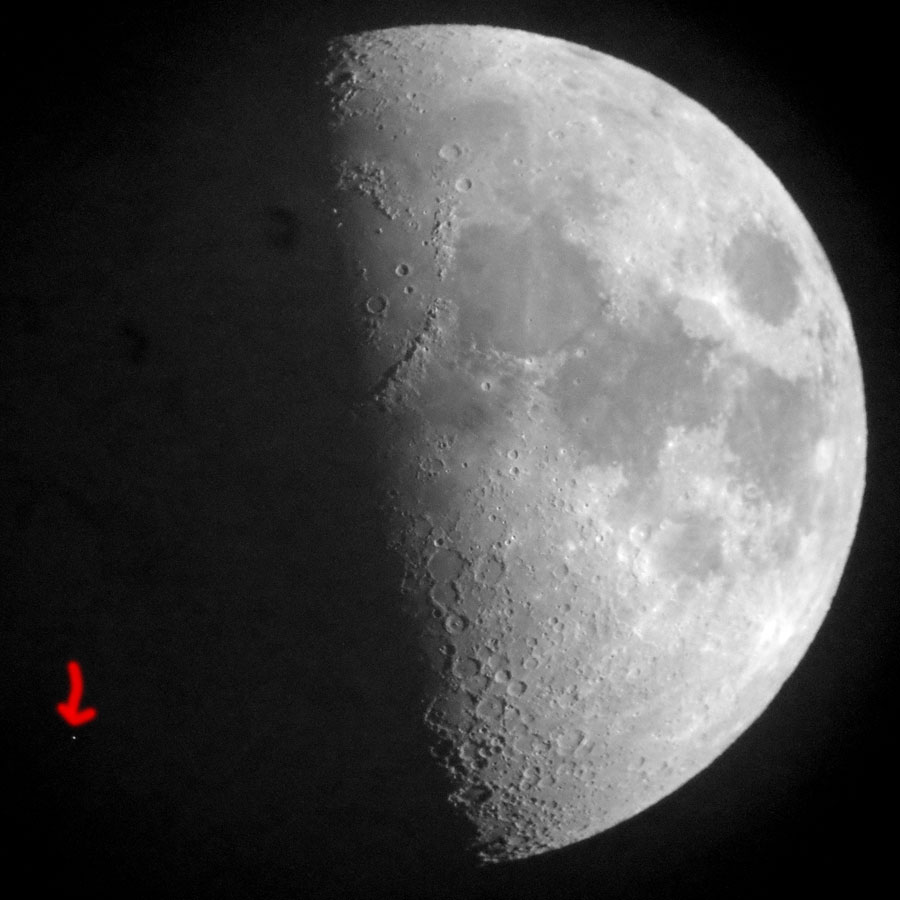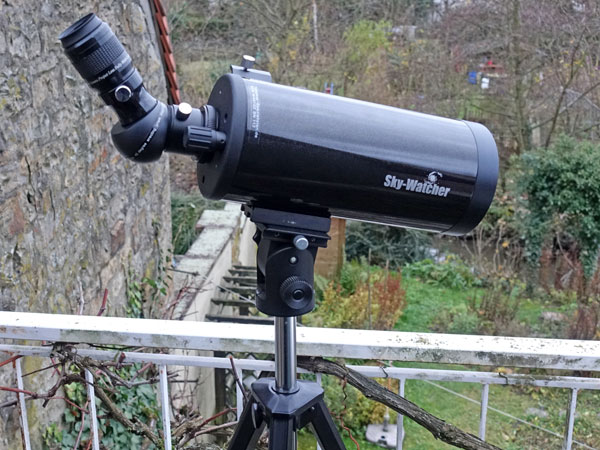Sky-Watcher Skymax-102 OTA Information (4" Maksutov-Cassegrain)
Motivation | Look | Look on Different Bases | Look of Skymax-102 OTA Compared with Skymax-127 OTA | Visited Sky Objects | First Photo Attempts | Skymax-102 OTA Used as a Spotting Scope | Conclusions | Links | Appendix: Data | Appendix 2: Sky-Watcher Skymax-102 Report
Archive
On this page, I present some information about my "planetary" telescope Sky-Watcher Skymax-102 OTA (ordered on May 23, 2016, received on May 28 after collimation at the dealers'). This is a compact, fairly light-weight 102 mm /1300 mm Maksutov-Cassegrain tube, and I intended to use it on my Virtuoso base, in addition to the Heritage 114P Dobsonian tube that was delivered with the Virtuoso base. Due to technical problems, however, I returned the Virtuoso. In spring 2017, I acquired a Sky-Watcher Star Discovery AZ GoTo telescope mount and used the Skymax-102 tube on this mount, on the Heritage 100P base, and preferably on the Sky-Watcher AZ Pronto mount that I bought in August 2018. On a further page, I describe how I used the Skymax-102 on the first two mounts. See the appendix for the data.
I also used the Skymax-102 as a spotting scope on a photo tripod and bought a 45° Amici prism for terrestrial observations (which can, of course, also be used together with the Skymax-127...).
| Note: In November 2017, I bought a used sample of the "bigger brother" of this telescope tube, Sky-Watcher Skymax-127 OTA (127 mm / 1500 mm), to get a little more "power" on the Star Discovery mount. Because the two tubes were very similar, I sold this nice little tube at the end of August 2018. I therefore can no longer report any experiences with this scope here. |
Motivation
Why did I buy the Sky-Watcher Skymax-102 OTA and for what purpose? The Skymax-102 OTA is a Maksutov-Cassegrain tube and combines high magnification with compact dimensions and a reasonable weight, however, at the expense of light intensity. It is a typical "moon, sun and planets" telescope and I purchased it for just this purpose in late May 2016, following a recommendation from a dealer. It filled a gap in my telescope collection and fulfilled a special task that cannot be solved by Newton tubes equally well. I was also able to observe a number of brighter deep sky objects, as well, in contrast to the Meade ETX 90/EC, which was disappointing in this respect.
However, I always considered replacing the Skymax-102 with the somewhat more powerful model Skymax-127 that has an aperture of 127 mm. My Astro dealer suggested this step as a possible "optimization" of my telescope collection (but later he withdrew this...). And that was exactly what happened in November 2017, when I bought a used Skymax-127 OTA! As there was no need for owning two very similars tubes, I sold this nice little tube at the end of August 2018.
Look
Unpacking, Bag
|
Outer package |
Ditto Package dimensions : Gross weight : 4 kg, net weight: 3 kg (gross weight 4,5 kg according to DHL) |
Ditto |
|
Ditto |
Outer package comparison with Sky-Watcher 114P Virtuoso |
Ditto |
|
In-between package |
Ditto |
Another box appears... |
|
All packages on one photo! |
Ditto |
Opening the inner-most box reveals a bag... |
|
Bag taken out of the box |
Small box with accessories unpacked |
Accessories unpacked |
|
Telescope tube taken auf of the bag |
Ditto, the screwdriver points to the diagonal mirror... |
Ditto with Heritage 100P base |
|
Bag opened, you can see the cover for the content |
Bag and cover for the content opened |
Bag with tube, which is wrapped in protective plastic |
Accessories: 10mm
and 25mm eyepieces, red dot finder, diagonal mirror, and more |
||
Collimation
|
The 6 Allen screws for collimation at the rear end of the tube |
The main mirror of the Sky-Watcher-102 OTA can be adjusted using 6 Allen screws, which are located at the rear end of the telescope. The small Allen screws are used for locking, the large ones for adjustment. Instructions from Teleskop-Express (translated, original in German): The collimation should be done directly at a star. Make it out of focus at a magnification of about 100 x. A dark shadow (the secondary mirror) should be exactly at the center. If it is not, you should adjust the telescope. Please proceed as follows:
The telescope is now collimated and will give you the best possible performance. |
|
Look on Different Bases
Telescope Tube on Heritage 100P Base
|
Skymax-102 on Heritage 100P base |
Ditto, front view |
Ditto, front view, closer |
|
Skymax-102 on Heritage 100P base, other side |
Skymax-102 on Heritage 100P base, seen more from the back |
Ditto, details (focuser, diagonal mirror) |
The tube is mounted against the "official" view direction. The locking knob for the tube was oriented so that the knob hit one of the three holes in the prism rail.
Telescope Tube on Omegon Mini Dobson Basis
As an alternative to the Heritage 100P base, I also use the tube on a simple Omegon Mini Dobson base.
|
Skymax-102 on Omegon Mini Dobson Base |
Ditto, front view |
Ditto other side |
|
Ditto, rear view |
|
|
The diagonal mirror hits the ground plate. You cannot rotate the tube complete - not a real problem.. |
Ditto, detail |
Ditto, detail |
The locking knob for the tube was oriented so that the knob hit one of the three holes in the prism rail. However, I found out that, when using the Omegon base, it is better to orient the locking knob towards the side of the prism rail that does not have holes.
Telescope Tube on Heritage P130 Base
Since the tube trembled too much for may taste on the two small bases, I also tried the base of the Heritage P130 for the Skymax-102 OTA. This base appears slightly too big for the tube, but is somewhat more stable than the two other bases and thus, trembles a little less. For home use, this base seems to be a good solution, but for travel purposes, it is too big and unwieldy.
|
Skymax-102 on Heritage P130 base, side view |
Ditto, other side |
Ditto, rear view, detail |
|
Ditto, rear view |
Ditto, rear view, tube vertical |
Ditto, rear view, tube horizontal |
|
Ditto, front view |
Ditto, front view, tube vertical |
Ditto, front view, tube horizontal |
The tube is mounted against the "official" view direction. The locking knob for the tube was oriented so that the knob hit one of the three holes in the prism rail.
Note: I gave the Heritage P130 away in mid-April 2017, so that I can no longer use this base for the Skymax-102 OTA.
Telescope Tube on Star Discovery AZ GoTo Mount
When I used the tube on my Sky-Watcher Star Discovery AZ GoTo mount, this regrettably resulted in an unusable position of the red dot finder*.
|
Skymax-102 tube on mount (overall view) |
Ditto (Detail) |
Front view - you can easily see the unusable position of the red dot finder |
|
Skymax-102 tube on mount, turned around (overall view) |
Ditto (detail) - you can easily see the unusable position of the red dot finder |
Rear view |
|
Ditto (detail) - you can easily see the unusable position of the red dot finder |
*) The OTA versions are meant to be used on an EQ mount and therefore do not fit optimally AZ mounts and Dobsonian bases.
Telescope Tube on AZ Pronto Mount
Last, but not least, I used the Skymax-102 tube on my new Sky-Watcher AZ Pronto mount.
Without Extension Tube
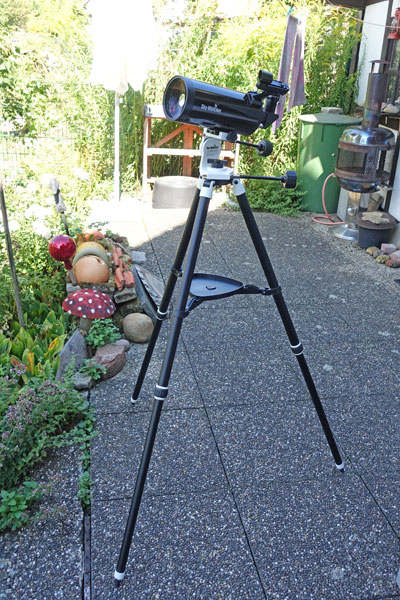 |
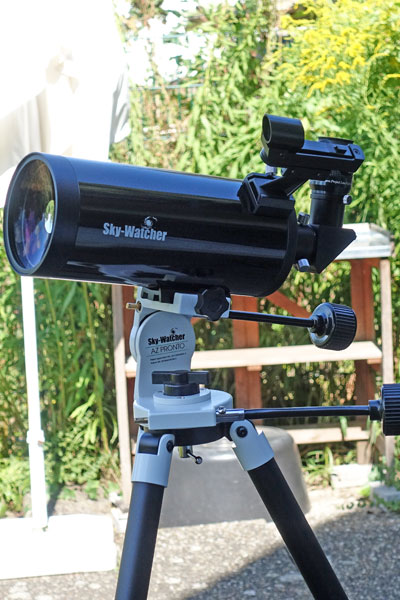 |
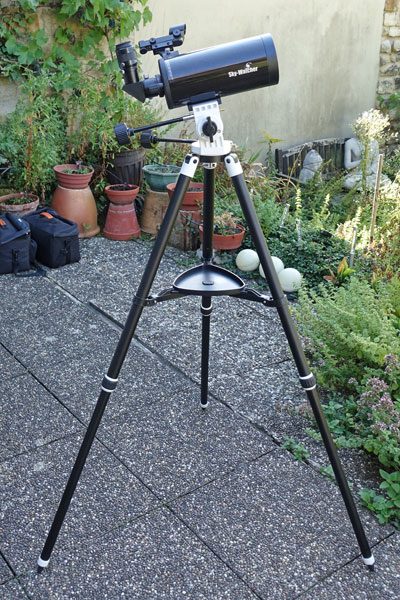 |
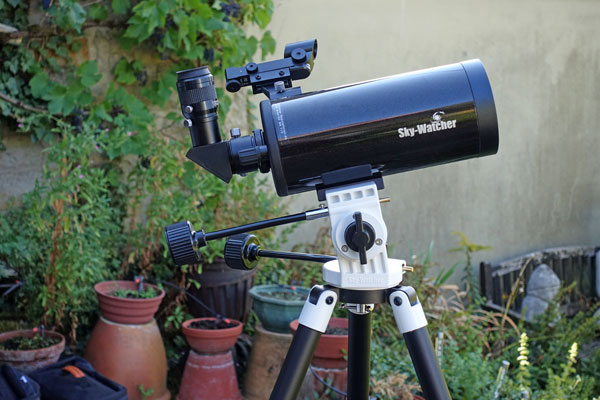 |
Side view |
Ditto (detail) |
Other side |
Ditto (detail) |
With Extension Tube
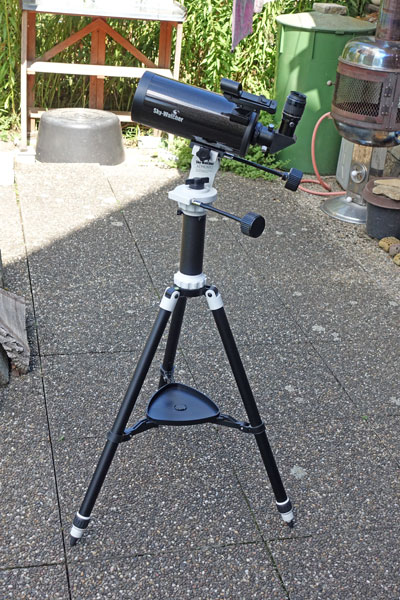 |
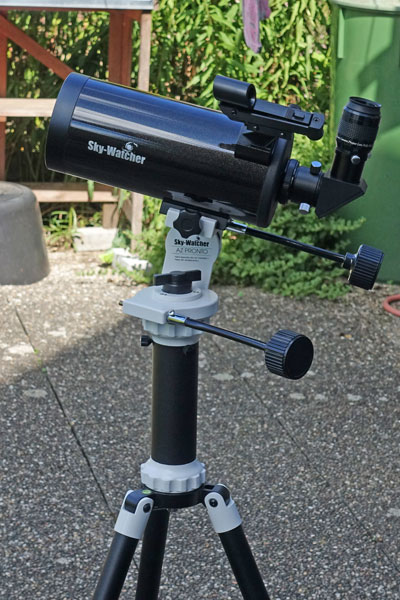 |
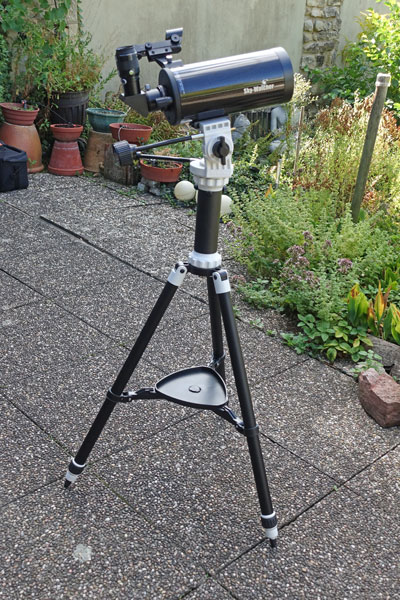 |
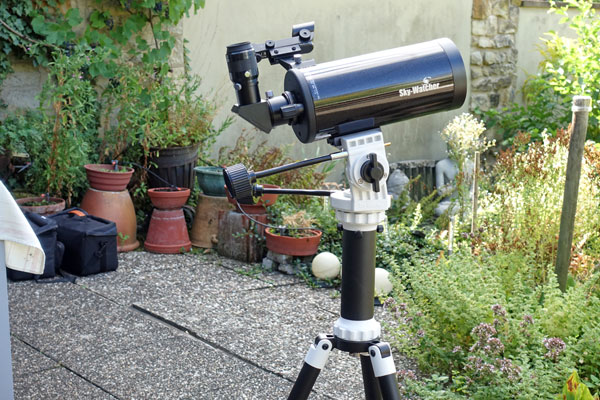 |
Side view |
Ditto (detail) |
Other side |
Ditto (detail) |
Telescope Tube on Photo Tripods
The Skymax-102 OTA can also be used on photo tripods because it is compact and not too heavy. This is also recommended for daytime use, when you use the tube as a "spotting scope" (the image is upright, but reversed; an Amici prism would provide a "normal", that is, upright and correct, view).
Detail views of the tube on my old Revue tripod |
|
Look of Skymax-102 OTA Compared with Skymax-127 OTA
Here, the Skymax-102 OTA is mounted on a Omegon Mini Dobsonian base, which actually is a little bit too shaky for this tube. But a Skymax-127 on the Heritage 100P is not better either...
|
Skymax-127 (left) and Skymax-102 (right), front view |
Ditto, side view |
Ditto, seen from the other side |
|
Ditto, rear view |
Ditto, oblique side view |
Ditto, oblique view from side |
|
Ditto, other view from the side |
Ditto, rear view |
Ditto, seen from the other side |
|
Ditto, seen from the rear |
The OTAs only |
Ditto, front view |
Skymax Tubes in Sky-Watcher Bag
|
Skymax-127 in bag |
Ditto, bag open |
Ditto, accessories visible |
|
Skymax-102 in bag |
Ditto, bag open, accessories in boxes can lie on the tube |
Ditto, accessories removed |
|
Ditto, the accessories can also be placed this way |
Skymax-127 in bag, accessories next to or on tube |
Both tubes with their accessories in their bags |
Visited Sky Objects
I visited (and documented) the following sky objects with the Sky-Watcher Skymax-102:
- Moon
- Venus (crescent), Jupiter (with moons; opposition, April 7, 2017; August 2018), Saturn (August 2018), Mars (August 2018)
- Double stars: Epsilon Lyrae (Double Double; August 2018) (without GoTo)
- With GoTo (autumn 2016): M 13, M 92, M 57, M 10, M 12, IC 4665, M 16/IC 4703, M 17, M 8/NGC 6530, M 11
- Without GoTo (spring 2017): M 35, M 42/43
- Without GoTo (January 2018): M 42/43
- Without GoTo (August 2018): M 13, M 56, M 57
Highlights
- Moon (Photos of the Moon April 2017, Photos of the Moon May 2017, Moon Covers Aldebaran February 2018, Photos of the Moon February 2018, Total Eclipse of the Moon 2018 (Blood Moon), Photos of the Moon August 2018)
- Planets: Venus (crescent), Jupiter (with moons), Saturn (with ring)
- DSO (globular cluster): M 13, M 92
- DSO (star cluster): M 35, M 45, NGC 884/869
- DSO (nebulae): M 42/43
First Photo Attempts
First Photos of the Venus Crescent with the Camera Held to the Eyepiece
On February 13, 2017, I tried to take some photos of Venus crescent with my Sky-Watcher Skymax-102 Maksutov-Cassegrain telescope. I used my Leica X Vario (1:50 method) for the photo and the following camera settings: manual mode, 1600 ASA, distance fixed to infinity.
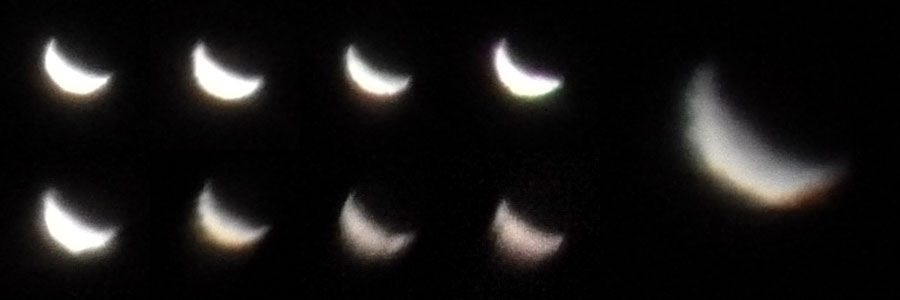
100% crops; the photo to the right was taken with a longer focal length of the camera; Leica X Vario
First Photos of the Moon with the Camera Held to the Eyepiece
The following photos of the moon were taken at the beginning of April 2017 (April 2 and 4 just after its beginning; on April 3, it was half moon). They were taken using the 1:50 method, that is, with the camera held to the eyepiece. In this case, I used my Ricoh GR (28 mm equivalent) at ISO 1600 and underexposed to avoid flare.
I used a 16 mm UWA and a 32 mm Plössl eyepiece. With the former, I was able to see the full moon, but not to "catch" it.
Regrettably, the photos are not as sharp as the ones that I took using the Sky-Watcher Explorer 150PDS at the same time.
April 2, 2017 |
||
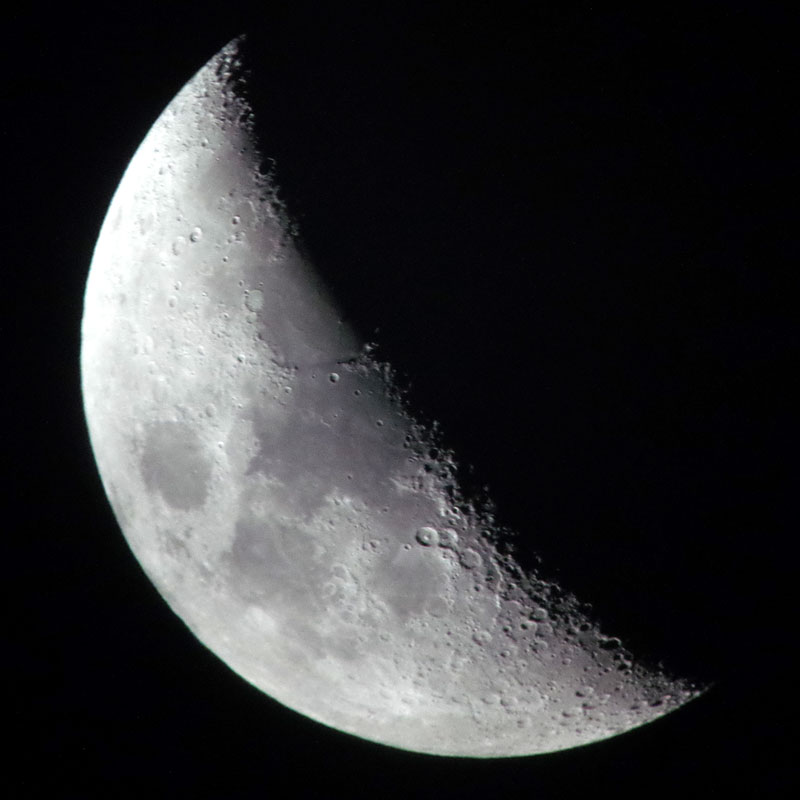 |
 |
|
32 mm eyepiece (approx. 40 x) - 1600 pixels version |
|
32 mm eyepiece (approx. 40 x) - 1600 pixels version |
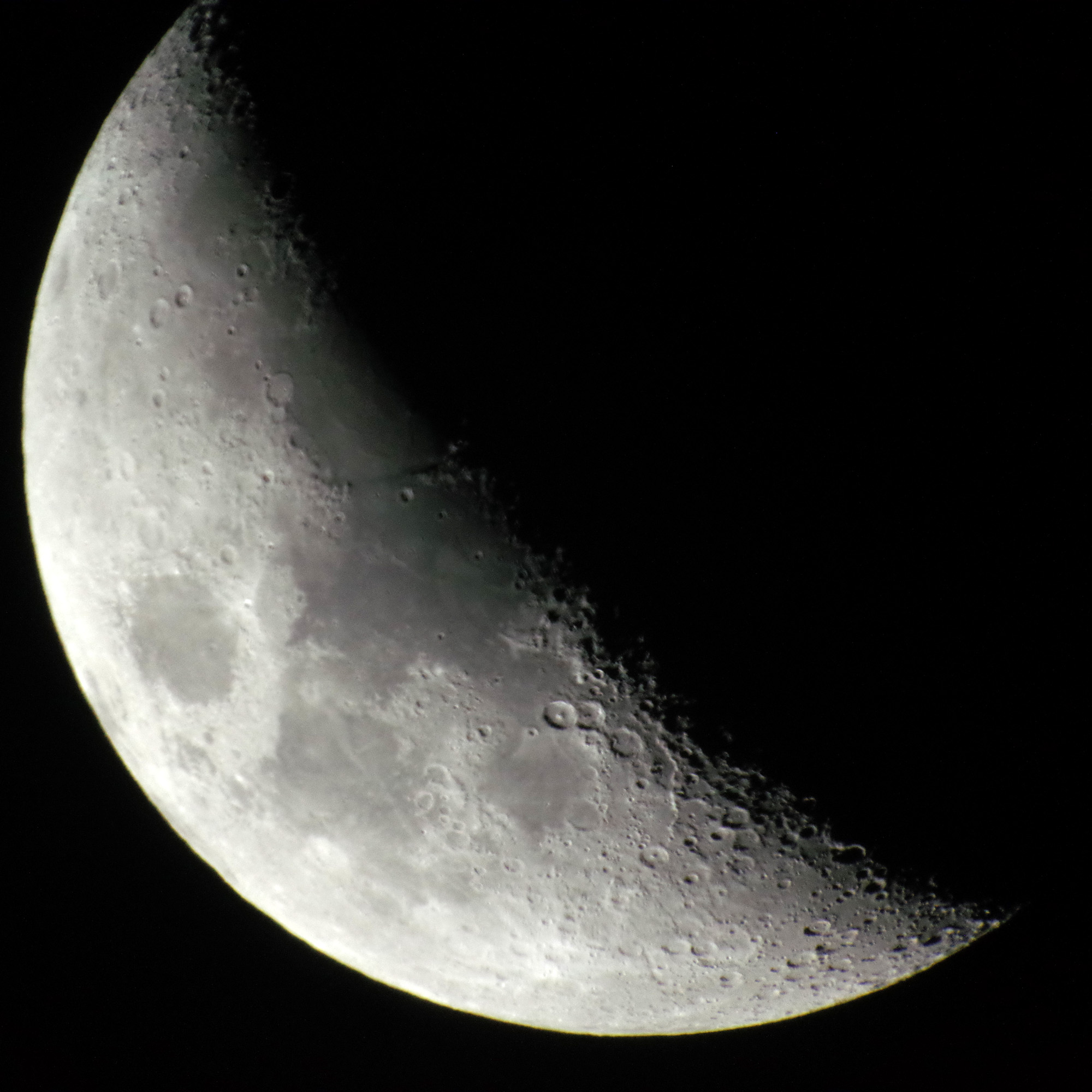 |
||
16 mm eyepiece (approx. 81 x) - 3200 pixels version |
||
April 4, 2017 (Just after its Beginning, Half Moon on April, 4) |
||
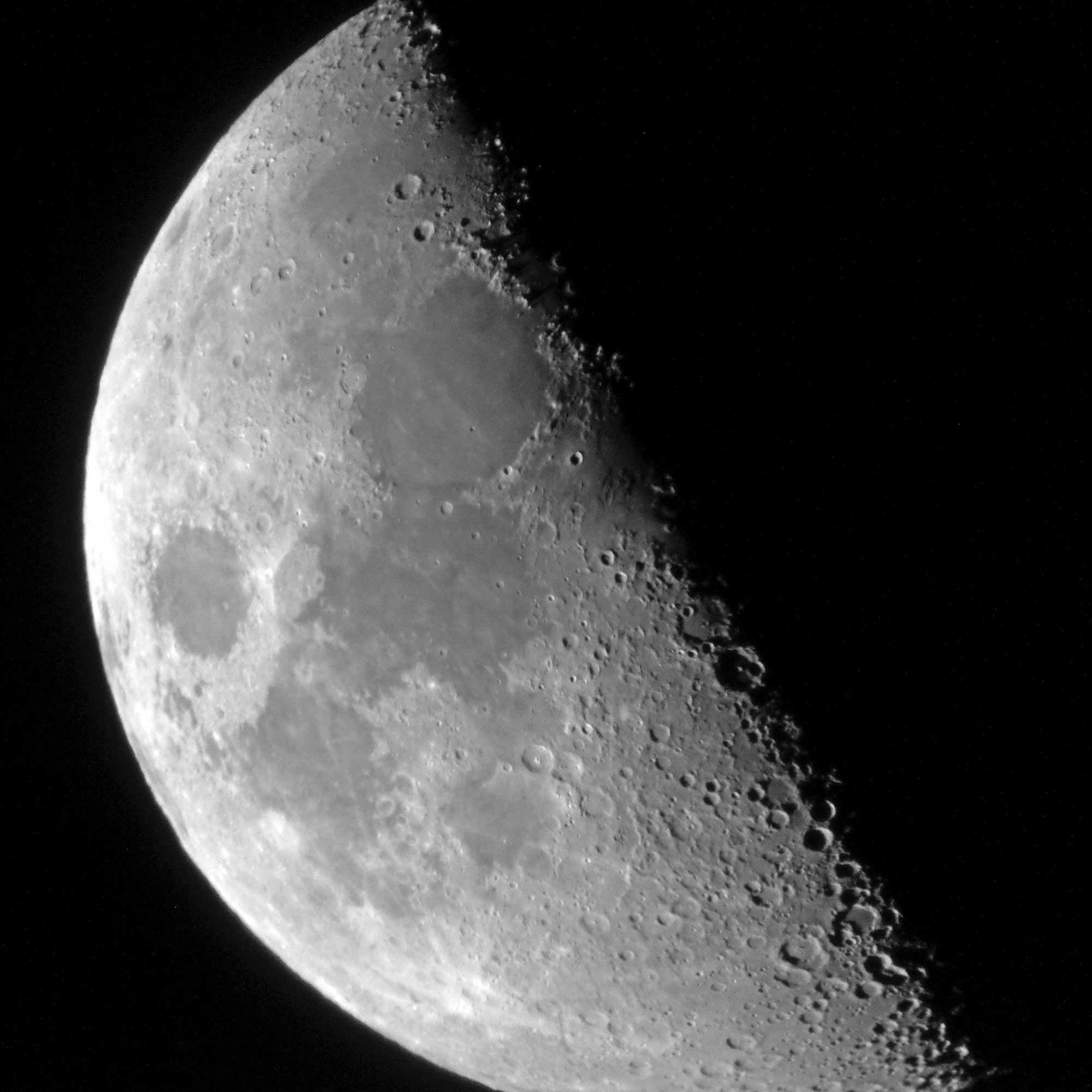 |
||
16 mm eyepiece (approx. 81 x) - 3200 pixels version |
||
April 4, 2017 |
||
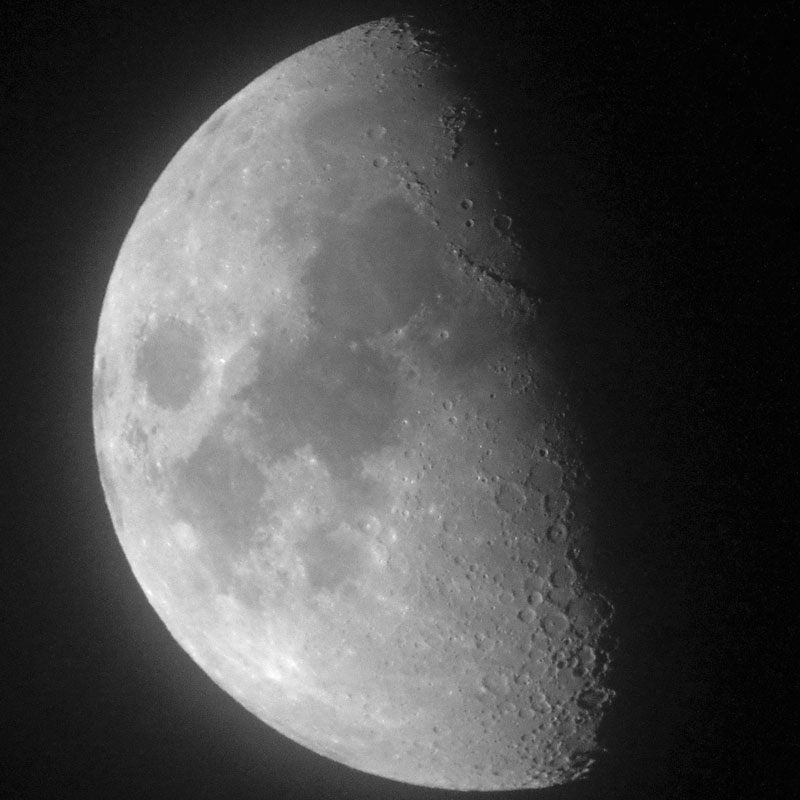 > > |
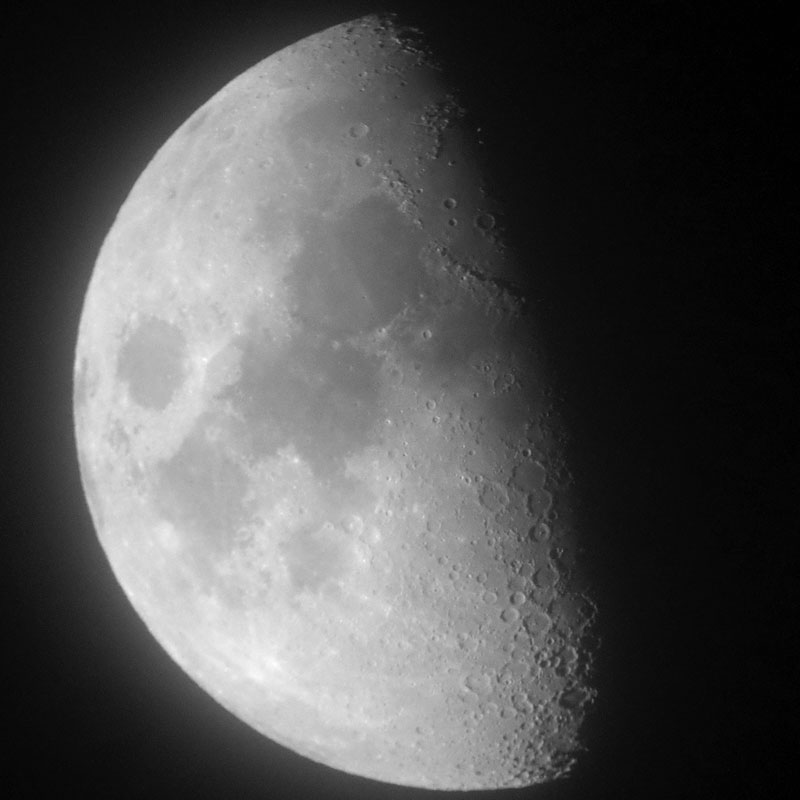 |
|
32 mm eyepiece (approx. 40 x) - 1600 pixels version B&W |
|
32 mm eyepiece (approx. 40 x) - 1600 pixels version B&W |
Comparison of the Days |
||||
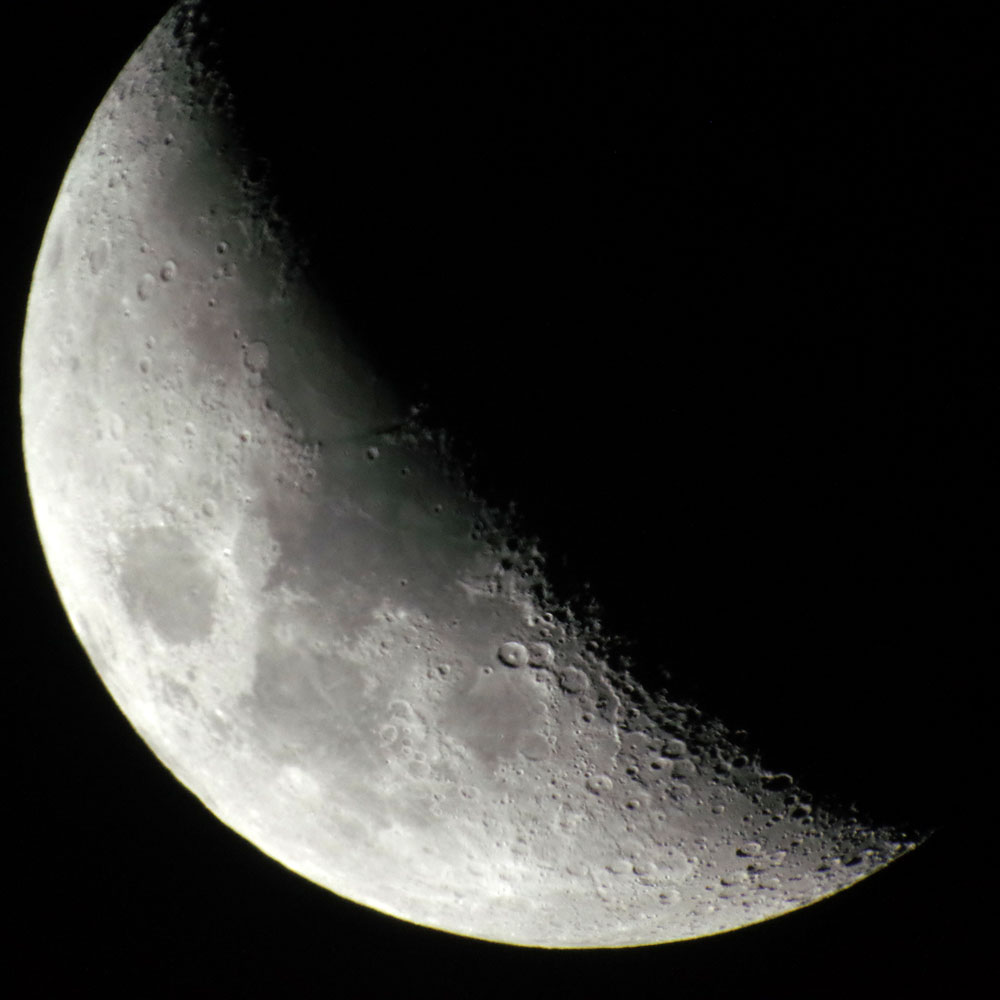 |
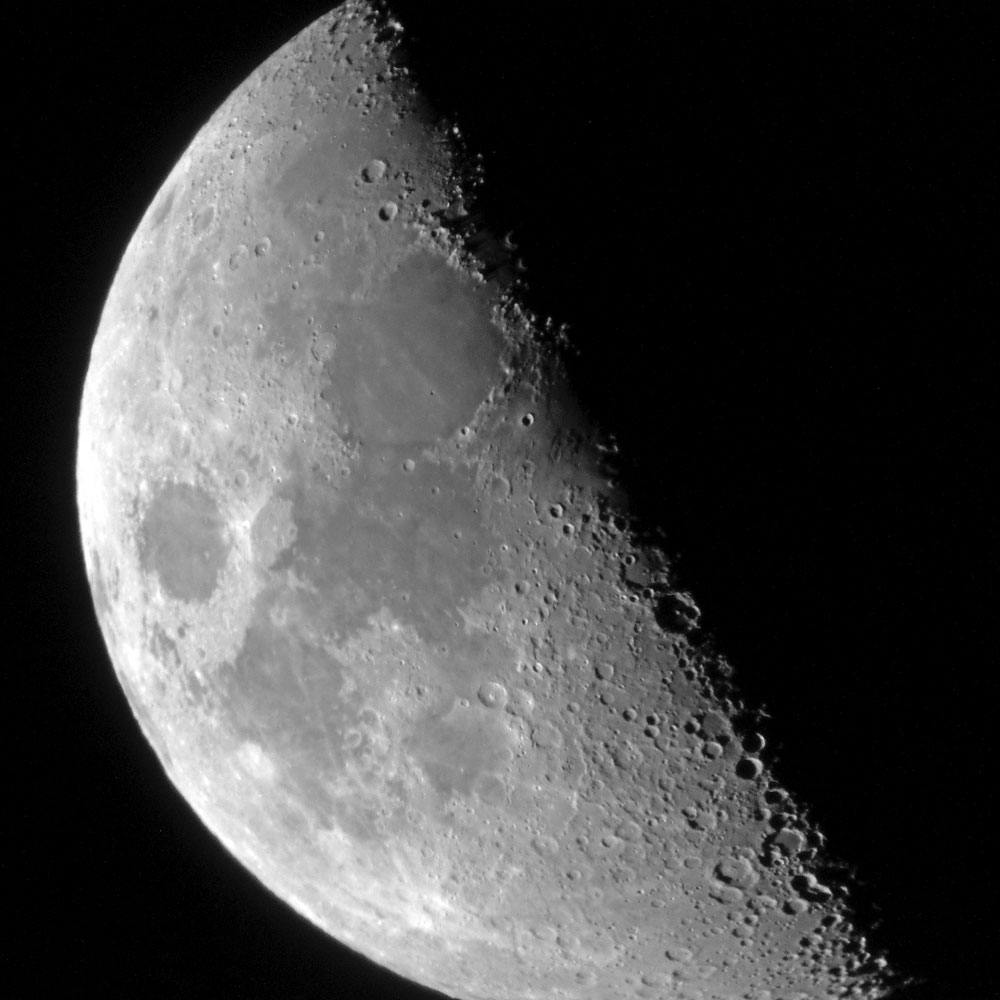 |
 |
||
April 2, 2017 |
April 4, 2017 (just started, half moon) |
April 4, 2017 | ||
The following photos of Saturn were taken on August 3, 2018 using the projections method, that is, with the Sony RX100 M4 attached to the eyepiece. I used ISO 1600 and once ISO 800 and underexposed to avoid blowing the highlights. I used a 32 mm Digiscope eyepiece with T-mount.
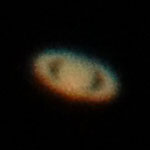 |
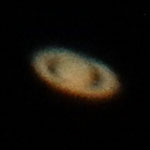 |
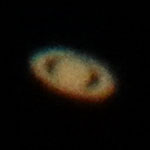 |
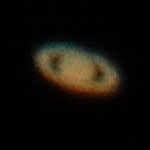 |
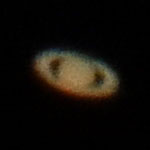 |
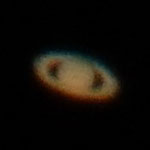 |
|||||
Photos cropped but not processed; the left 5 photos were taken with ISO 1600, the right one with ISO 800 |
||||||||||
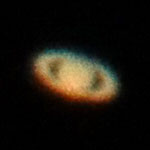 |
 |
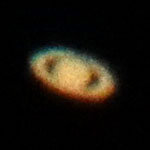 |
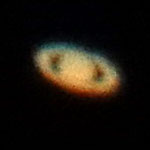 |
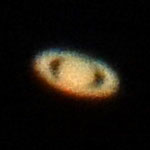 |
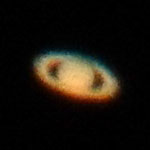 |
|||||
Photos made lighter |
||||||||||
Photos of the Moon with Camera Screwed to the Eyepiece
On February 27, 2018, I took a series of moon photos with my Leica M (Type 240) and a Minolta 28 mm lens attached to the eyepiece. Most of the resulting photos were, however, blurred. In order to investigate the conditions for the camera shake more closely, I varied the exposure times. In contrast to the Skymax-127, I got the relatively clear result that shots under 1/1000 sec exposure time are mostly blurred. For 1/1000 sec and shorter, I am often lucky that they are sharp. Even shorter exposure times lead to underexposure and would have to be compensated by a higher ISO number (I already used ISO 3200). Neither underexposure nor a higher ISO number increase the quality of the photos...
Conclusion: Only with very short exposure times do I get really sharp photos with this combination, and typically, that is rarely the case. The potential is there, but the results with the Skymax-127 seem to be slightly better than those with the Skymax-102. This may, however, also be due to the selected images or just coincidence... Here are some selected sample photos:
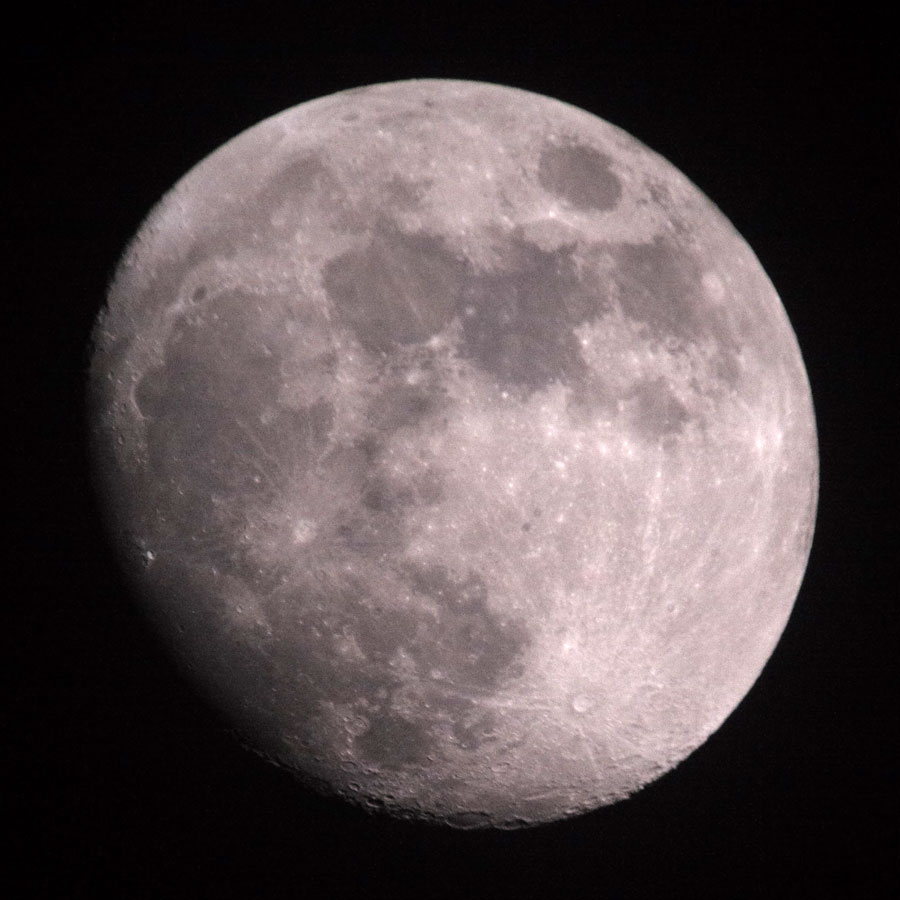 |
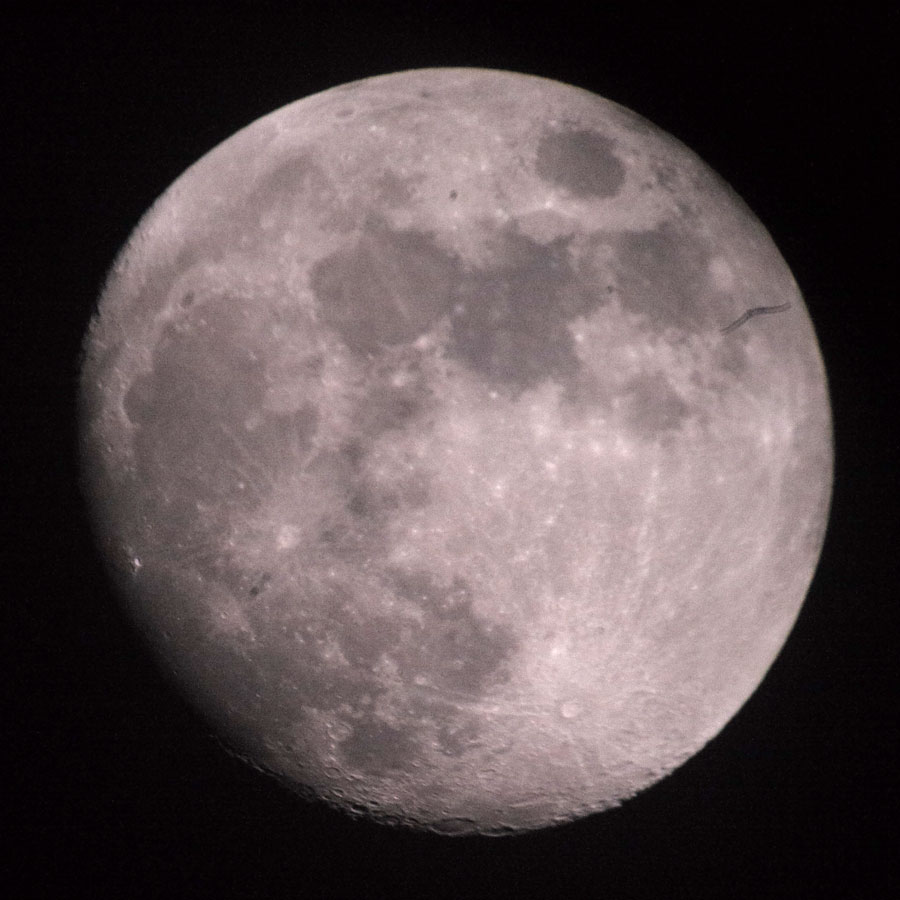 |
|
Post-processed, exposure time 1/1000 - 2400 pixels |
Post-processed, exposure time 1/1000 - 2400 pixels |
|
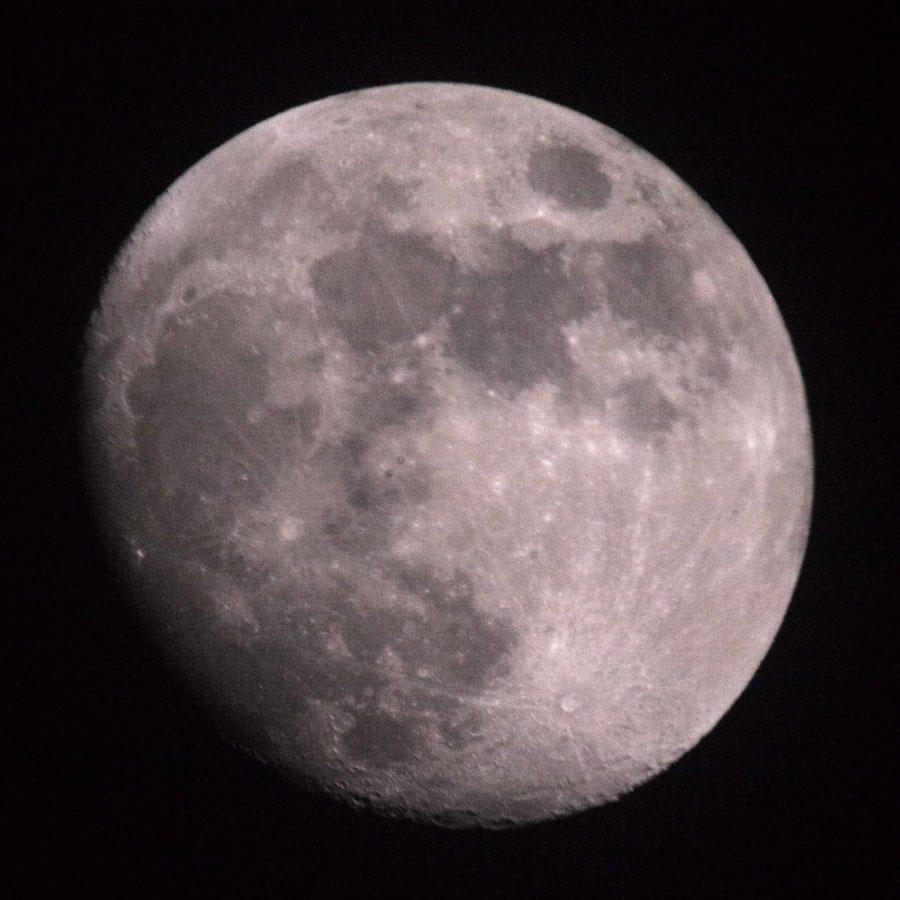 |
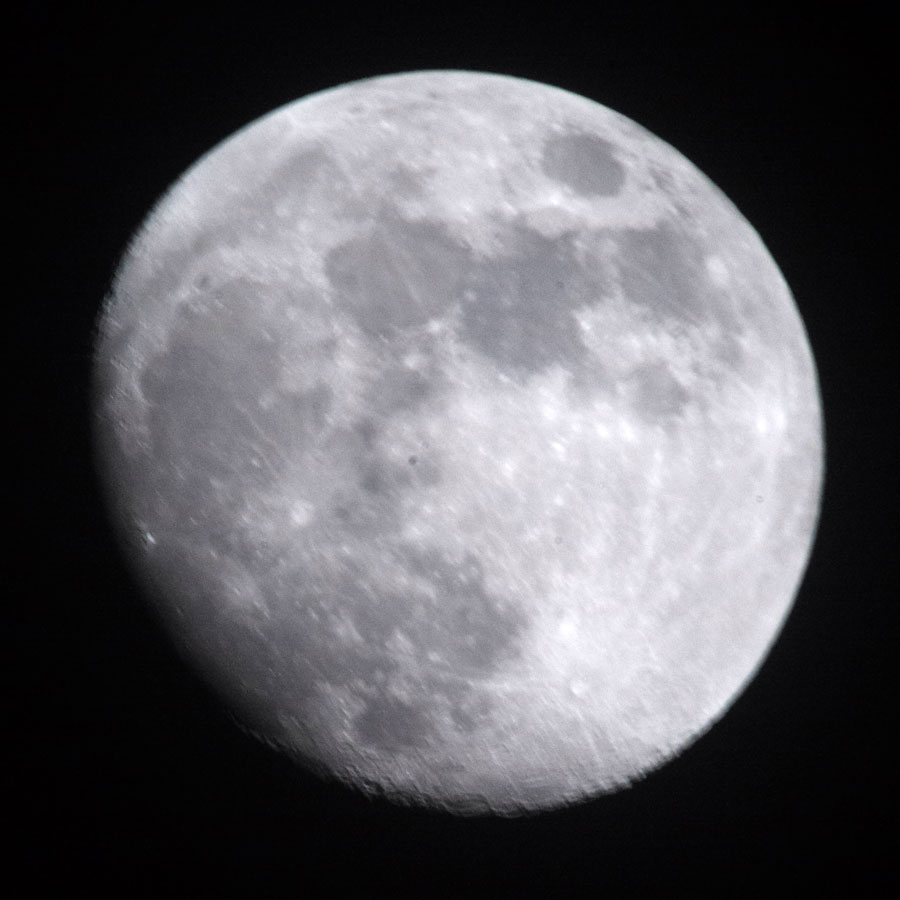 |
|
Post-processed, exposure time 1/1500, somewhat underexposed - 2400 pixels |
Post-processed, exposure time 1/500, blurred - 2400 pixels |
|
 |
 |
|
Section from the southern hemisphere, my sharpest sample |
Ditto; same exposure time, but less sharp |
|
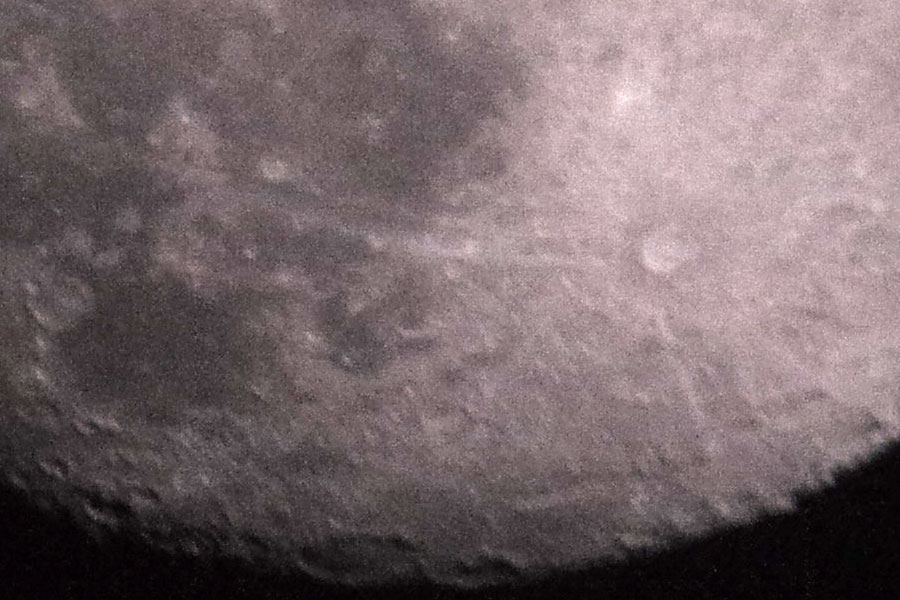 |
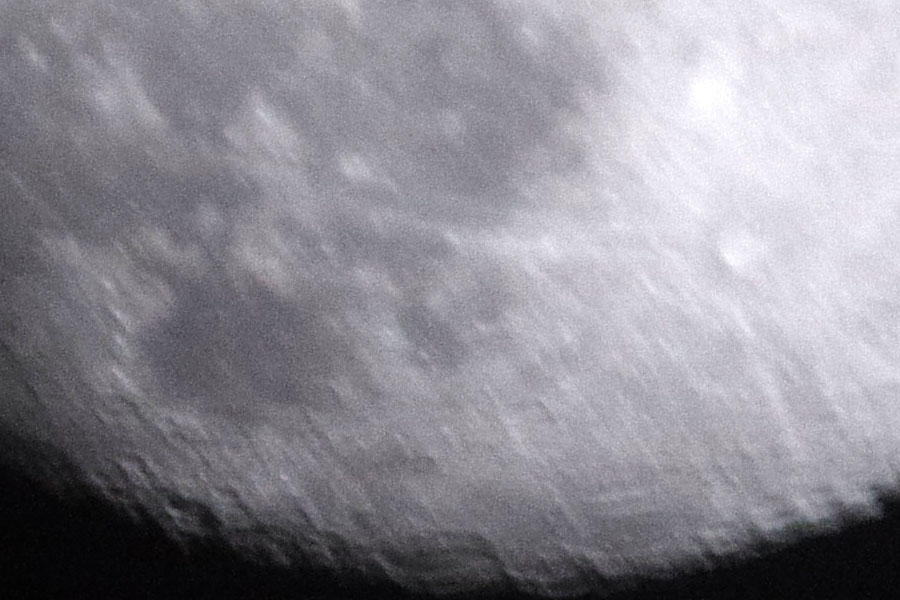 |
|
Ditto; more noise due to underexposure and less sharp than the photo above... |
Ditto; blurred, because of 1/500 sec exposure time ... |
Photos Using a T-Mount Adapter
On February 23, 2018, I attempted to take photos of the moon covering Aldebaran, using my Skymax-127 OTA and my Leica M (Typ 240) connected by a T-mount adapter. The telescope is used as a camera lens (1500 mm, f/11.8) for this type of mounting. The results are described elsewhere and are overall disappointing, because almost all images are blurred despite using a cable release.
I took only a few photos of the moon with the Skymax-102, because it quickly became clear that these were not satisfying, even though it looked like this in the viewfinder at first, i. e. as if the photos were sharp. But despite or because of using a cable release, the photos are not sharp. However, unlike with the Skymax-127, it seems to be a problem of focusing rather than shake (although double contours appear on a few photos). Why the photos are so blurred, although they looked sharp in the viewfinder during quick review, is beyond my knowledge...
Original view |
Original view |
|
 |
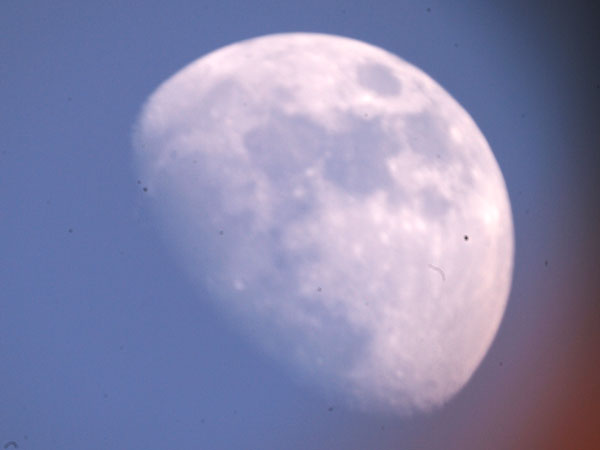 |
|
Section of the photo above |
Section of the photo above |
For Comparison: Ricoh GR Held to the Eyepiece
In addition to the Skymax-127 with the Leica M camera, I prepared my Skymax-102 OTA so that my wife would be able to observe the Aldebaran occultation in parallel. Fortunately, I occasionally took pictures with the Ricoh GR at this telescope. Namely, as I found out later, the results with the Leica M at the Skymax-127 were simply disappointing. So I got, at least, some reasonable photos of the covering of Aldebaran. And you can see here that using this telescope you can take nice photos of the moon, even using the 1:50 method.
Before |
||
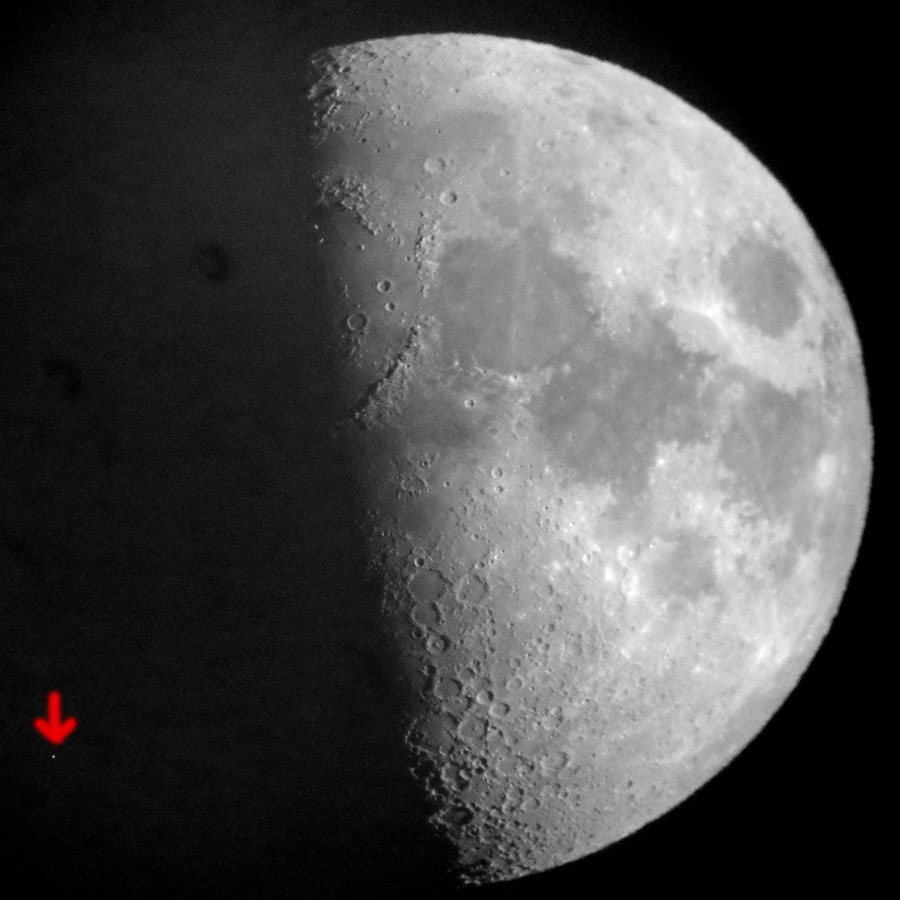 |
||
After |
||
 |
||
Skymax-102 OTA Used as a Spotting Scope
The Skymax-102 can be used as a spotting scope for terrestrial observations, although it is a bit large and heavy for such usage. For achieving an upright and correct image, an Amici prism can be used. I bought a Baader Amici prism with an angle of 45°, because this is more comfortable for terrestrial observations than 90° (Baader BA2956150 1.25"/45° Amici prism). With my 32 mm eyepiece, I got a magnification of about 40 x, with my 24 mm eyepiece, one of 54 x (my 24 mm eyepiece has a larger field of view, though, so that I got nearly the same true field of view...).The spotting scope was mounted to an old Revue photo tripod (see the photos above).
 |
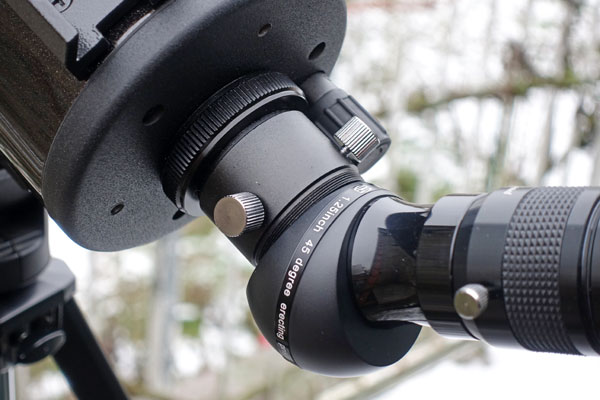 |
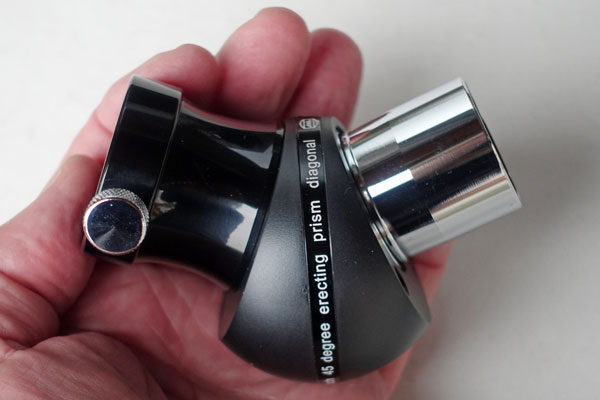 |
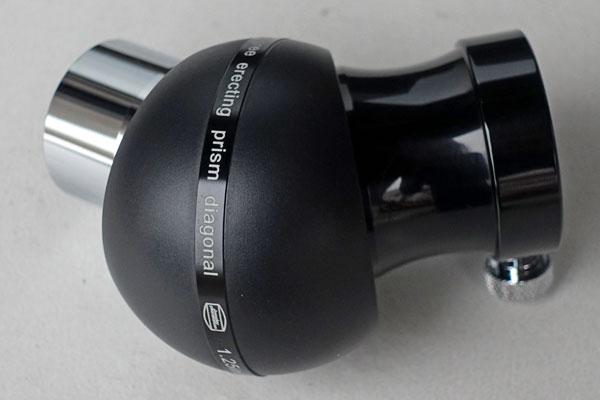 |
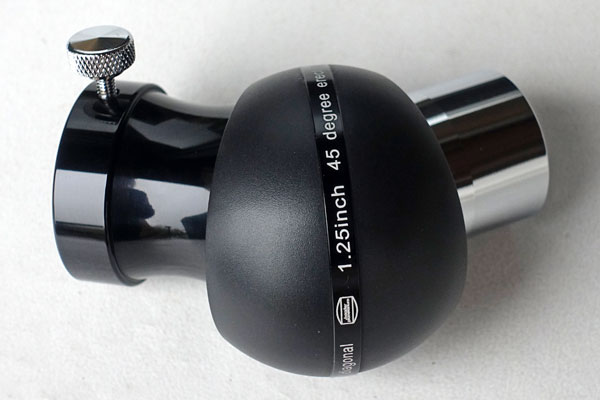 |
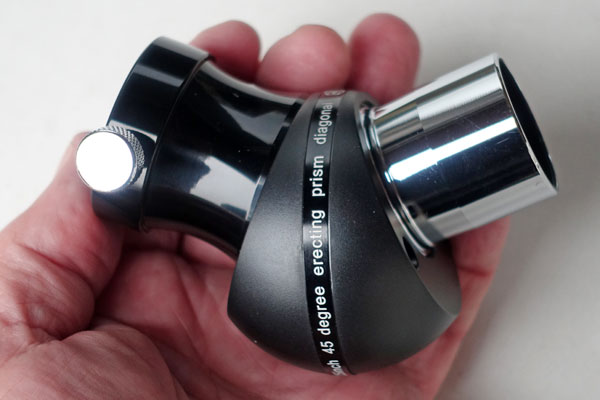 |
Photos: The Baader Amici prism
First Photo Attempts
Here are a few not very sharp first photo attempts with the Skymax-102 as a spotting scope, where I held the Sony RX100 M4 to the eyepiece (32 mm):
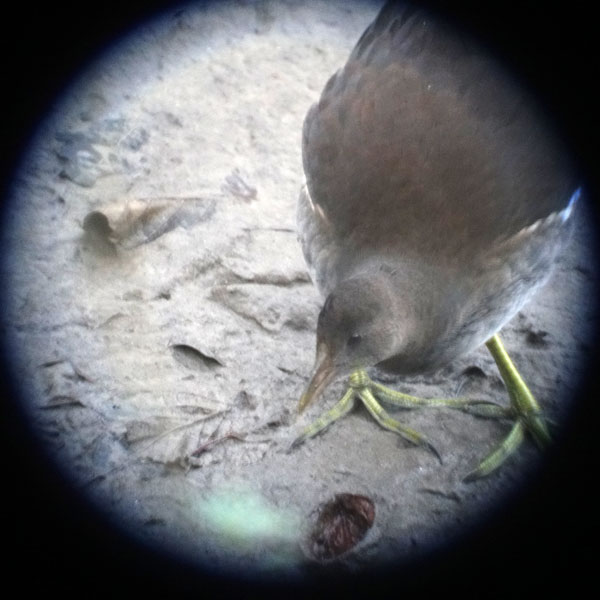 |
 |
Photo data: November 28, 2017, ISO 1600, focal length 24 mm (equiv.)
Another Attempt...
Here, I mounted the Sony RX100 M4 fix to the eyepiece (32 mm) using the Lensmate filter adapter and some more adapters:
 |
 |
 |
||
Photo data: March 2, 2018, ISO 1600, focal length 50 mm (equiv.)
Note: In original size the photos do not look very sharp...
Third Attempt: At the Binshof Lakes Near Speyer
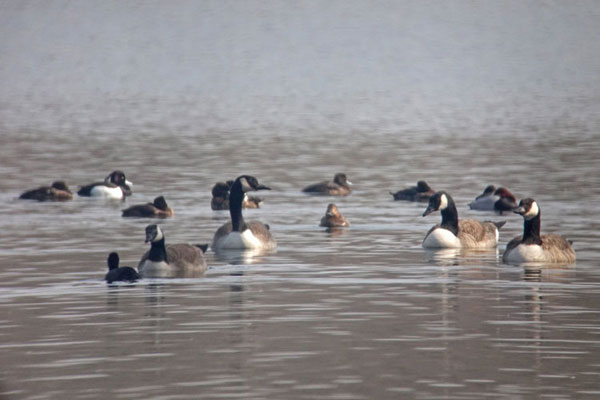 |
 |
 |
||
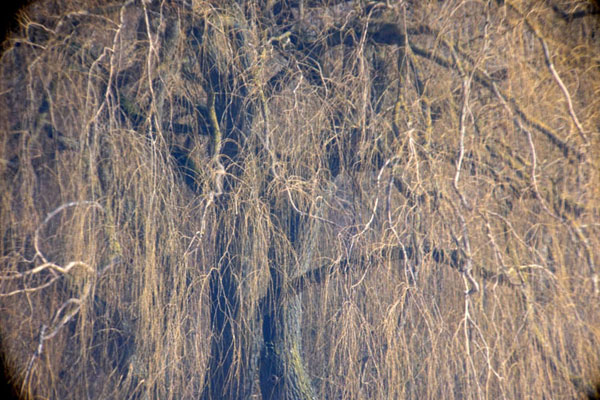 |
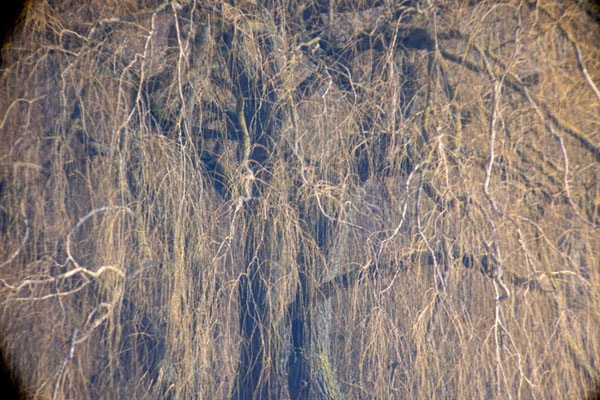 |
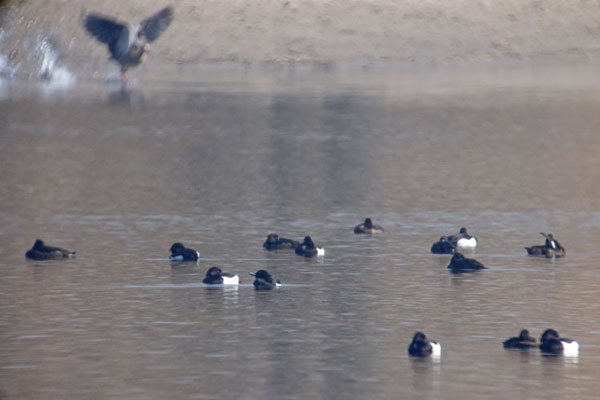 |
||
 |
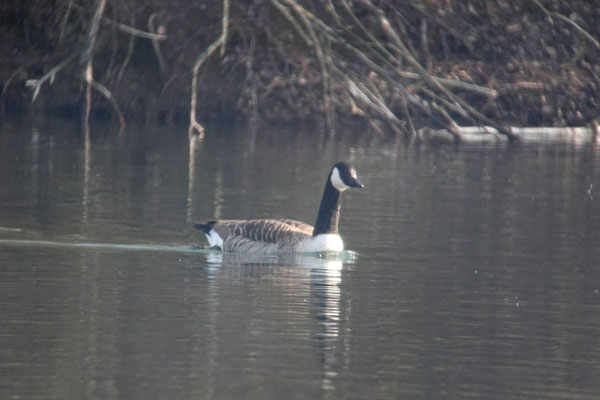 |
 |
Photo data: March 4, 2018, ISO 800, focal length 52 mm (equiv.)
Note: In original size the photos do not look very sharp. Overall, the sharpness results are disappointing. The only somewhat sharper photo is the one that shows the heron.
Conclusions
OTA
The Skymax-102 OTA is a Maksutov-Cassegrain tube and thus, plays in a somewhat "different league" than my Dobson telescopes (or Newton tubes). It is small and handy and weighs about 2 kg, which makes it feel surprisingly heavy - probably because it is so small and so much heavier than my Heritage 100P.
While I cannot confirm that its optical performance is better than that of Newtons or Dobsons, as is often claimed and will certainly be true, I see its main advantage in the combination of a high magnification with compact dimensions and a reasonable weight, however, at the expense of light intensity (focal ratio f/12.7). It is therefore a typical "moon, sun, and planet" telescope, and I bought it, following a dealer's recommendation, exactly for this purpose. In contrast to the, in this respect, disappointing Meade ETX 90/EC, I was also able to observe a number of brighter deep-sky objects. All in all, this tube filled a gap in my telescope collection and fulfilled a special task that cannot be performed by Newton tubes equally well.
I was, however, thinking about replacing it one day I with the slightly more powerful model with an aperture of 127 mm. My astronomy dealer had suggested this as a possible way to "optimize" my telescope collection (but later he withdrew this...). And exactly that happened in November 2017, when I bought a used Skymax-127 OTA! And since I had no need for two very similar tubes, I finally sold this nice little tube at the end of August 2018.
Compared with the Skymax-127 OTA, it proved difficult to me to find substantial differences in the optical performance of the two tubes, especially since the conditions were never exactly the same. With the Orion Nebula M 42, however, the Skymax-127 seemed, in my impression, to have a slight edge: the nebula cloud seemed to be somewhat more differentiated and the "wings" (see the photo below for illustration) could be seen more clearly:
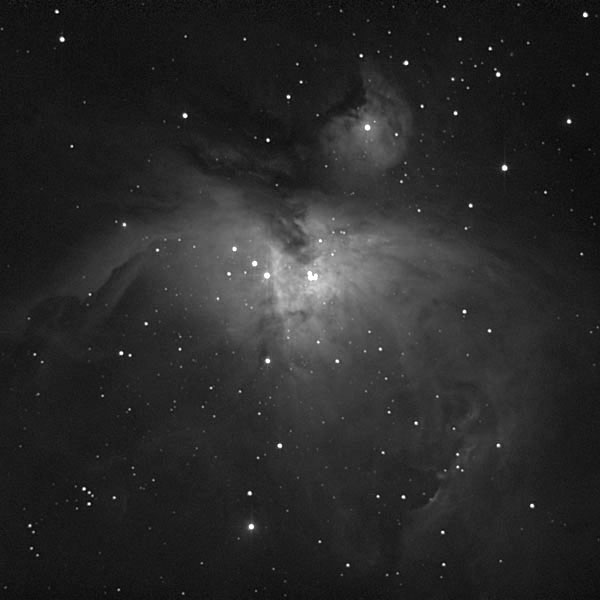
Photo: Photo of M 42/43 with Atik Infinity (B&W version) with Explorer 150PDS
I did a further comparison using the open star cluster M 35. In the Skymax-127, the star cluster seemed to me more vivid and more contrasty at first, but when I looked longer through the eyepieces, the visual impression became very similar in both tubes.
At the end of February 2018, I photographed the moon with both Skymax tubes in different configurations. Apart from the problems of camera shake when the Leica M (type 240) was fixed to the telescope or eyepiece, the few sharp results were fine and comparable, although I got the impression that the Skymax-127 has a slight edge, particularly, since it produces a somewhat larger image due to the longer focal length. The latter was fine for my 32 mm eyepiece, to which I can attach a camera with a T-mount adapter.
At the beginning of August 2018, I took photos of Saturn using both telescopes and a Sony RX100 M4. The photos taken with the Skymax-127 showed Saturn a little bit larger and with less color fringes. At the end of August 2018, I also took a series of moon photos spread over about a week. In the end, I was not able to find notable differences between the two tubes.
Overall, I think that, for deep sky objects, the Skymax-127 has a slight advantage over the Skymax-102. The latter is, however, much easier to handle thanks to its smaller size and lower weight. Both (the 127 just so ...) fit the Sky-Watcher bag, which is delivered with the 102 and which I bought for my used 127 tube afterwards. Filled with the tubes and their accessories, the bags weigh 2.8 kg or 4.3 kg (but our balance is not exact...).
Note: I discuss this on the Skymax-127 page in more detail.
|
Skymax-127 in bag, accessories in front compartment |
Skymax-102 in bag, accessories can lie on tube |
Both tubes in their bags with accessories |
Bases
I tried the Skymax-102 OTA on four different bases and finally came to somewhat different conclusions than I had initially assumed. Since the Skymax-102 tube is significantly heavier than the Heritage 100P tube and also magnifies more than three times more at the same focal length of the eyepiece, the trembling of the small bases is more noticeable with this tube. Therefore, whenever I wanted to do without GoTo, I always used the more stable P130 base (even if it was not free of trembling either) at home at the beginning. But since I gave the P130 away in mid-April 2017, this option no longer existed and I had to return to using the 100P base. On holidays, on the other hand, I chose the 100P base anyway because of the lack of space. If I wanted to use the tube with GoTo, the Star Discovery AZ GoTo mount came into play. This was, however, only be the case at home.
Lacking a suitable manual mount for my tubes, I finally bought a Sky-Watcher AZ Pronto mount in August 2018. This mount seemed ideal for the Skymax-102 tube (the viewfinder was located correctly) and made fun. But this was only a short partnership...
Use on Tripods and as A Spotting Scope
The Skymax-102 OTA can also be used on photo tripods because it is compact and not too heavy. This is also recommended for daytime use, when you use the tube as a "spotting scope" (the image is upright, but reversed). An Amici prism provides a "normal" view, and I therefore bought one for terrestrial observations.
Last Words
Possibly, the differences in size, weight, and handiness between the Skymax-102 and Skymax-127 are more pronounced than the differences in optical performance. Driven by the desire for even better optical performance, I purchased a used, larger Skymax-127, as soon as there was a good opportunity. And because I am not a collector, I decided to part with my Skymax-102. Whether this decision was right, I will probably (and hopefully) never find out...
Links
- Sky-Watcher Company Website, USA: www.skywatchertelescope.net (the Skymax-102 OTA is not found as OTA on Sky-Watcher Website, only with an equatorial mount)
- Pages from German distributors for the Sky-Watcher Skymax-102 OTA:
- Teleskop-Spezialisten (here I bought the telescope): www.teleskop-spezialisten.de/shop/Maksutov-Cassegrain-MAK/100-145mm/SkyWatcher-Skymax-102-OTA-102mm-1300mm-Maksutov-Cass-optischer-Tubus::308.html (in German)
- Teleskop-Service/Express: www.teleskop-express.de/shop/product_info.php/info/p1052_Skymax-102-OTA---102-1300mm-Maksutov-Cass----optischer-Tubus.html (in German) - www.teleskop-express.de/shop/product_info.php/language/en/info/p1052_Skymax-102-OTA---102-1300mm-Maksutov-Cass----optischer-Tubus.html (in English)
- Astroshop: www.astroshop.de/skywatcher-maksutov-teleskop-mc-102-1300-skymax-ota/p,5021 (in German) - www.astroshop.eu/skywatcher-maksutov-telescope-mc-102-1300-skymax-ota/p,5021 (in English)
- Pages from German distributors for the Omegon Mount Dobsonian mini base
with synta dovetail:
- Astroshop: www.astroshop.de/azimutal-ohne-goto/omegon-mini-dobson-montierung/p,46439 (in German) - www.astroshop.eu/alt-azimuth-without-goto/omegon-mount-dobsonian-mini-base-with-synta-dovetail/p,46439 (in English)
- Omegon (belongs to Astroshop): www.omegon.eu/de/azimutal-ohne-goto/omegon-mini-dobson-montierung/p,46439 (in German) - www.omegon.eu/alt-azimuth-without-goto/omegon-mount-dobsonian-mini-base-with-synta-dovetail/p,46439 (in English)
- See also my page offering Astronomy Links.
Appendix: Data for Sky-Watcher Skymax-102 OTA
| Telescope: Sky-Watcher | Skymax-102 |
| Optical Design | Maksutov-Cassegrain |
| Primary Mirror Diameter | 102 mm (4") |
| Focal Length, Focal Ratio | 1300 mm, f/12.7 |
| Resolving Power (arc secs) | 1.15" |
| Limiting Visual Stellar Magnitude | 12.7 mag |
| Light Gathering Power | 212.3 |
| Maximum Practical Visual Power | 204 x |
| Optical Tube Dimensions (diam. x length) | 11.6 cm x 27 cm |
| Net Weight Basis | --- |
| Net Weight Optical Tube | 1.9 kg |
| Net Weight Complete |
Dark Blue: Telescopes that I still own; italic and dark red: telescopes that I owned; black: for comparison; *) own measurement; **) corrected values
See also the table of data for all of my telescopes (and a few more...)
Observation-Relevant Data (in Comparison with other Cassegrain Tubes)
| Telescope | Focal |
Aperture (mm) |
Focal Ratio |
Light Gathering Power |
Maximum+ |
Minimum* |
Maximum* |
Minimum+ |
|||||
Usable Magnification |
Usable Focal
Length of Eyepiece (mm) |
||||||||||||
Factor/Exit Pupil (mm) > |
Manuf. |
1.5 |
2 |
6.5 |
7 |
6.5 |
7 |
1.5 |
2 |
||||
| ETX 90/EC (Maksutov-Cassegrain) | 1250 |
90 |
13.89 |
165 |
325 |
135 |
180 |
13.84 |
12.85 |
90.4 |
97.3 |
9.3 |
6.9 |
| Skymax-102 (Maksutov-Cassegrain) | 1300 |
102 |
12.75 |
212 |
153 |
204 |
15.69 |
14.57 |
82.9 |
89.3 |
8.5 |
6.4 |
|
| Skymax-127 (Maksutov-Cassegrain) | 1500 |
127 |
11.81 |
329 |
191 |
254 |
19.54 |
18.14 |
76.8 |
82.7 |
7.9 |
5.9 |
|
| Celestron C8 (Schmidt-Cassegrain) | 2032 |
203 |
10 |
841 |
305 |
406 |
31.26 |
29.03 |
65.0 |
70.0 |
6.7 |
5.0 |
|
| Cel. C8 (Schmidt-Cassegrain) (Red.) | 1280 |
203 |
6.3 |
841 |
305 |
406 |
31.26 |
29.03 |
41.0 |
44.1 |
4.2 |
3.2 |
|
*) Calculated for an exit pupil of 6.5 mm and 7 mm
+) Factor 1.5 or 2 for Dobsonian/Newtonian telescopes; in general, the lower
value of 1.5 is used for Newtonian telescopes; if the manufacturer specified
a different magnification, it is also listed (some manufacturer provide considerably
higher numbers...).
Visual Power (Magnification) and Other Data for Different Focal Lengths of Eyepieces (Mostly My Current Eyepieces)
Note: These tables include the StarTravel 120 refractor, a TSWA32 eyepiece (2", 32 mm focal length, 70° viewing angle) that I borrowed together with the StarTravel 120, a 18 mm eyepiece (2", 82° viewing angle), a 38 mm eyepiece (2", 70° viewing angle), and a 56 mm eyepiece (2", 52° viewing angle).
| Telescope | Further Data |
Focal Length of Eyepiece (mm) |
|||||||||||||
| Magnification | |||||||||||||||
Focal Length of Telescope (mm) |
4 |
7 |
10 |
16 |
18 |
24 |
26 |
28 |
32 |
32 |
35 |
38 |
40 |
56 |
|
| PS 72/432 | 432 |
108.00 |
61.71 |
43.20 |
27.00 |
24.00 |
18.00 |
16.62 |
15.43 |
13.50 |
13.50 |
12.34 |
11.37 |
10.80 |
7.71 |
| ST120 | 600 |
150.00 |
85.71 |
60.00 |
37.50 |
33.33 |
25.00 |
23.08 |
21.43 |
18.75 |
18.75 |
17.14 |
15.79 |
15.00 |
10.71 |
| TLAPO1027 | 714 |
178.50 |
102.00 |
71.40 |
44.63 |
39.67 |
29.75 |
27.46 |
25.50 |
22.31 |
22.31 |
20.40 |
18.79 |
17.85 |
12.75 |
| 150PDS | 750 |
187.50 |
107.14 |
75.00 |
46.88 |
41.67 |
31.25 |
28.85 |
26.79 |
23.44 |
23.44 |
21.43 |
19.74 |
18.75 |
13.39 |
| SM127 | 1500 |
375.00 |
214.29 |
150.00 |
93.75 |
--- |
62.50 |
--- |
--- |
46.88 |
--- |
--- |
--- |
--- |
--- |
| SM102 | 1300 |
325.00 |
185.71 |
130.00 |
81.25 |
--- |
54.17 |
--- |
--- |
40.63 |
--- |
--- |
--- |
--- |
--- |
| C5 | 1250 |
312.50 |
178.57 |
125.00 |
78.13 |
--- |
52.08 |
--- |
--- |
39.06 |
--- |
--- |
--- |
--- |
--- |
| C5 (Red.) | 787.5 |
196.88 |
112.50 |
78.75 |
49.22 |
--- |
32.81 |
--- |
--- |
24.61 |
--- |
--- |
--- |
--- |
--- |
| C8 | 2032 |
508.00 |
290.29 |
203.20 |
127.00 |
112.89 |
84.67 |
78.15 |
72.57 |
63.50 |
63.50 |
58.06 |
53.47 |
50.80 |
36.29 |
| C8 (Red.) | 1280 |
320.00 |
182.86 |
128.00 |
80.00 |
--- |
53.33 |
--- |
--- |
40.00 |
--- |
--- |
--- |
--- |
--- |
| True Field of View (°) | |||||||||||||||
Apparent Field
of View (°) > |
82 |
82 |
72 |
82 |
82 |
65 |
70 |
56 |
52 |
70 |
69 |
70 |
68 |
52 |
|
Focal Length of Telescope (mm) |
4 |
7 |
10 |
16 |
18 |
24 |
26 |
28 |
32 |
32 |
35 |
38 |
40 |
56 |
|
| PS 72/432 | 432 |
0.76 |
1.33 |
1.67 |
3.04 |
3.42 |
3.61 |
4.21 |
3.63 |
3.85 |
5.19 |
5.59 |
6.16 |
6.30 |
6.74 |
| ST120 | 600 |
0.55 |
0.96 |
1.20 |
2.19 |
2.46 |
2.60 |
3.03 |
2.61 |
2.77 |
3.73 |
4.03 |
4.43 |
4.53 |
4.85 |
| TLAPO1027 | 714 |
0.46 |
0.80 |
0.91 |
1.84 |
2.07 |
2.18 |
2.55 |
2.20 |
2.33 |
3.14 |
3.38 |
3.73 |
3.92 |
4.08 |
| 150PDS | 750 |
0.44 |
0.77 |
0.96 |
1.75 |
1.97 |
2.08 |
2.43 |
2.09 |
2.22 |
2.99 |
3.22 |
3.55 |
3.63 |
3.88 |
| SM127 | 1500 |
0.22 |
0.38 |
0.48 |
0.87 |
--- |
1.04 |
--- |
--- |
1.11 |
--- |
--- |
--- |
--- |
--- |
| SM102 | 1300 |
0.25 |
0.44 |
0.55 |
1.01 |
--- |
1.20 |
--- |
--- |
1.28 |
--- |
--- |
--- |
--- |
--- |
| C5 | 1250 |
0.26 |
0.46 |
0.58 |
1.05 |
--- |
1.25 |
--- |
--- |
1.33 |
--- |
--- |
--- |
--- |
--- |
| C5 (Red.) | 787.5 |
0.42 |
0.73 |
0.91 |
1.67 |
--- |
1.98 |
--- |
--- |
2.11 |
--- |
--- |
--- |
--- |
--- |
| C8 | 2032 |
0.16 |
0.28 |
0.35 |
0.65 |
0.73 |
0.77 |
0.90 |
0.77 |
0.82 |
1.10 |
1.19 |
1.31 |
1.34 |
1.43 |
| C8 (Red.) | 1280 |
0.26 |
0.45 |
0.63 |
1.03 |
--- |
1.22 |
--- |
--- |
1.30 |
--- |
--- |
--- |
--- |
--- |
| Exit Pupil (mm) | |||||||||||||||
Focal Ratio |
4 |
7 |
10 |
16 |
18 |
24 |
26 |
28 |
32 |
32 |
35 |
38 |
40 |
56 |
|
| PS 72/432 | 6 |
0.67 |
1.17 |
1.67 |
2.67 |
3.00 |
4.00 |
4.33 |
4.67 |
5.33 |
5.33 |
5.83 |
6.33 |
6.67 |
9.33 |
| ST120 | 5 |
0.80 |
1.40 |
2.00 |
3.20 |
3.60 |
4.80 |
5.20 |
5.60 |
6.40 |
6.40 |
7.00 |
7.60 |
8.00 |
11.20 |
| TLAPO1027 | 7 |
0.57 |
1.00 |
1.43 |
2.29 |
2.57 |
3.43 |
3.71 |
4.00 |
4.57 |
4.57 |
5.00 |
5.43 |
5.71 |
8.00 |
| 150PDS | 5 |
0.80 |
1.40 |
2.00 |
3.20 |
3.60 |
4.80 |
5.20 |
5.60 |
6.40 |
6.40 |
7.00 |
7.60 |
8.00 |
11.20 |
| SM127 | 11.81 |
0.34 |
0.59 |
0.85 |
1.35 |
--- |
2.03 |
--- |
--- |
2.71 |
--- |
--- |
--- |
--- |
--- |
| SM102 | 12.75 |
0.31 |
0.55 |
0.78 |
1.26 |
--- |
1.88 |
--- |
--- |
2.51 |
--- |
--- |
--- |
--- |
--- |
| C5 | 10 |
0.41 |
0.71 |
1.02 |
1.63 |
--- |
2.44 |
--- |
--- |
3.25 |
--- |
--- |
--- |
--- |
--- |
| C5 (Red.) | 6.3 |
0.65 |
1.13 |
1.61 |
2.58 |
--- |
3.87 |
--- |
--- |
5.16 |
--- |
--- |
--- |
--- |
--- |
| C8 | 10 |
0.40 |
0.70 |
1.00 |
1.60 |
1.80 |
2.40 |
2.60 |
2.80 |
3.20 |
3.20 |
3.50 |
3.80 |
4.00 |
5.60 |
| C8 (Red.) | 6.3 |
0.63 |
1.11 |
1.59 |
2.54 |
--- |
3.81 |
--- |
--- |
5.08 |
--- |
--- |
--- |
--- |
--- |
Blue: Equipment borrowed for comparison purposes; gray: sold equipment; italic: 2" eyepieces
Magnification: Yellow: low (30-50 x); magenta: medium
(80-100 x); violet: high (150-200 x - and more); red: beyond
maximum usable magnification.
Exit pupil: Values in magenta cells are
either too small (< 1 mm) or too large (> 6.4/7 mm); yellow background:
best for galaxies (about 2-3 mm).
Recommendations for the Focal Lengths of Eyepieces for Skymax-102 (Following My Recommendations and Those of Others)
| Criteria | Exit Pupil |
Focal
Length of Eyepiece |
|||||
| Category | Application Area | from...to |
Calculated |
On the Market |
Examples |
Proposals |
|
| Maximum FOV | Search | 7 |
10 |
89-128 |
---** |
--- |
--- |
| Minimum Magnification / Large FOV | Overview, large-area nebulae | 4.5 |
6.5 |
57-83 |
---** |
--- |
--- |
| Normal Magnification | Large-area, faint nebulae; nebulae, open star clusters | 3.5 |
4 |
45-51 |
40** |
40** |
--- |
| Best for many objects, e.g. for most galaxies, and mid-size DSO | 2 |
3 |
26-38 |
25-40 |
25, 26, 32 |
25, 32 |
|
| Maximum Magnification / Maximum Resolution | "Normal" upper magnification limit; globular star clusters | 1 |
1.5 |
13-19 |
12-20 |
12, 15, 16, 18, 20 |
12.5, 18 |
| Maximum perceptibility of small, low-contrast
details; planetary nebulae, small galaxies; maximum magnification for moon and planets |
0.6 |
0.8 |
8-10 |
8-10 |
8, 9, 9.5, 10 |
8, 10 |
|
| Separation of narrow double stars, small planetary
nebulae; perception of faintest details |
0.4 |
0.5 |
5-6 |
5-6 |
5, 6 |
6 |
|
*) Partly available as 2" eyepiece; **) typically no suitable 1,25" eyepieces available; problems with viewing at 40 mm; italic: not possible; red: magnification too high; blue: commercial focal lengths
Appendix 2: Sky-Watcher Skymax-102 Report (for Teleskop-Spezialisten)
In the early summer of 2016, I started to dig a little deeper into the observation of sky objects. However, my Dobson/Newtonian tubes were not ideal for observing the moon and the planets. I therefore bought the Sky-Watcher Skymax-102 OTA at the end of May 2016, following a recommendation by Mr. Kloß. As a Maksutov-Cassegrain tube, it combines a high magnification with compact dimensions and reasonable weight, but at the expense of aperture ratio. This makes it a typical "moon, sun and planets" telescope - and that is exactly what I bought it for.
Observations
With the Skymax-102 I observed the moon and the planets in the first place and was very satisfied with the performance of the small, compact, and despite a weight of only 2 kg "heavy" appearing tube. I took the photos either with the camera held to the eyepiece or with the camera screwed to my 32 mm Digiscope eyepiece. The latter of course resulted in a more evenly distributed sharpness and better image quality. The former allowed the use of shorter eyepiece focal lengths and thus higher magnification. With the moon, however, I mostly limited myself to images of the whole moon.
I was also able to observe a number of brighter deep sky objects, in contrast to the disappointing Meade ETX 90/EC (but maybe I was not ready yet...). I visited the following sky objects with the Sky-Watcher Skymax-102:
- Moon (including the occultation of Aldebaran by the moon in February 2018 and the total lunar eclipse in July 2018)
- Venus (sickle), Jupiter (with moons; opposition, April 7, 2017; August 2018), Saturn (August 2018), Mars (August 2018)
- Double Stars: Epsilon Lyrae (Double Double Star; August 2018)
- With GoTo (Autumn 2016): M 13, M 92, M 57, M 10, M 12, IC 4665, M 16/IC 4703, M 17, M 8/NGC 6530, M 11
- Without GoTo (Spring 2017): M 35, M 42/43
- Without GoTo (January 2018): M 42/43
- Without GoTo (August 2018): M 13, M 56, M 57
Use as A Spotting Scope
Later, I bought an Amici prism for using the Skymax-102 as a spotting scope as well. Due to its small size and low weight I was able to take the Skymax-102 in my backpack on a short hike. The minimum magnification I achieved (32 mm) was about 40 x, which was often too much in the vicinity, but just right for tits at feeding place. For photos at larger distances, such as ducks on a lake, this fitted better! All in all, I was not quite satisfied with the contrast and sharpness when using the Skymax-102 as a spotting scope.
Mounts
Initially, I did not have a suitable mount for the Skymax-102 and often used it on the bases of my Mini-Dobsons (Heritage 100P, P130). But I had to mount it "against the direction of view", otherwise the viewfinder would be at the bottom left. I also used it on my GoTo mount (Sky-Watcher Star Discovery), and the only thing I could do was to have the viewfinder at the bottom left - it was not possible to mount the tube in the opposite direction. In August 2018, I bought a Sky-Watcher AZ Pronto mount, on which the Skymax-102 is mounted horizontally, and the viewfinder is "correctly" positioned, that is, at the top right. I also used the Skymax-102 on photo tripods, especially when using it as a spotting scope, but that was a bit shaky...
Changes...
However, I was always wondering if I should replace my Skymax-102 with the more powerful model with 127 mm aperture. And in November 2017 I actually bought a used Skymax-127 OTA. I often compared both tubes and was not able to find any significant differences, especially since the conditions were never exactly comparable.
Overall, I think the Skymax-127 has a slight advantage over the Skymax-102 for deep sky objects and planets. On the other hand, the latter is much easier to handle thanks to its smaller size and lower weight. Both tubes fit into the Sky-Watcher bag (the 127 just so...), which belongs to the 102 and which I bought for my used 127 tube. In the bag and with accessories, the tubes weigh 2.8 kg and 4.3 kg respectively (but our scale is not accurate...). I consider both tubes as "travelable".
Ultimately, everyone has to decide for themselves what is more important to them:
- manageability, lower weight, smaller size and according to Mr. Kloß the more beautiful image (I cannot confirm this)
- or a slightly better performance with DSO, perhaps higher contrast at least in some situations, probably also when used as a spotting scope, and in some situations less color fringes with planets
Because I had no need for two very similar telescope tubes, I sold the nice little Skymax-102 at the end of August 2018.
Conclusions on Skymax-102
The Skymax-102 did not disappoint me, especially with respect to observing moon and planets, but also with respect to observing brighter DSO. If you prefer its bigger "brother" or that one, is a matter of personal preferences.
| 21.11.2024 |
